Recent Fire Damage Posts
Fire Damage Incidents In Your Southern McHenry County Property
11/1/2022 (Permalink)
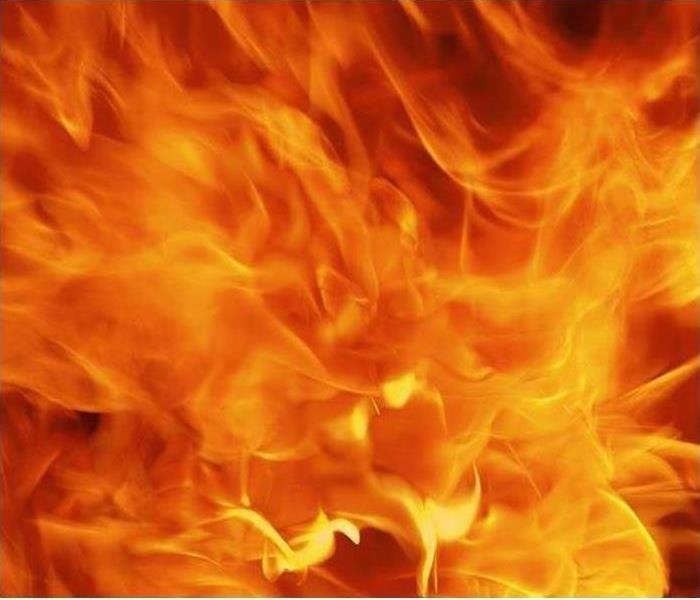 The first step to resolving fire damage is calling your local trained professionals at SERVPRO.
The first step to resolving fire damage is calling your local trained professionals at SERVPRO.
Various Reasons Fire Damage Incidents In Southern McHenry County Can Leave Property Uninhabitable
Fires can start anywhere in a property, causing widespread damage. In many cases, such incidents displace the occupants. Although most fires start in the kitchen, fires can start in other parts of the property. Faulty appliances or unattended candles are other likely sources of sparks that lead to fire damage.
Although the extent of a fire damage incident in Southern McHenry County is the primary determinant of whether the continued occupation of a house is possible, other factors play a role too. Common reasons why house occupants may need to vacate the house for restoration include:
- Massive residue deposits on surfaces and contents
- Severe structural damage, including holes in the walls or roof
- Noxious fumes or bad odor
- Damaged utilities such as plumbing or electrical lines
A single factor or a combination of several factors can make a house uninhabitable immediately after a fire. Our SERVPRO technicians scope the loss site thoroughly to establish all issues that may affect you or your family if you continue occupying the house. In the case of noxious fumes and aerosols, ventilating the property with axial fans, which move large volumes of air across a wide area, helps remove the contaminated air inside the house faster.
Structural or utility damages can lead to life-threatening situations. Our SERVPRO technicians can handle some of these damages, including boarding up openings on walls and installing tarps on the roof in case the fire leaves a gaping hole. Such stopgap measures help keep a property habitable until complete repairs can be done. In case of severe damage, such as when frames and other structural supports are damaged, we involve construction specialists. The damage to utility lines like power cables and water pipes also varies. Our crews use circuit testers to identify electrical faults. In case of severe damage, we strip off the wires so they can be replaced.
Regaining access to your property after a fire incident is a top priority, although it is not always easy. Call SERVPRO of Southern McHenry County at (847) 516-1600 to help. We’re Faster to Any Size Disaster.
Where Do I Start the Cleanup After a Kitchen Fire in Southern McHenry County?
11/1/2022 (Permalink)
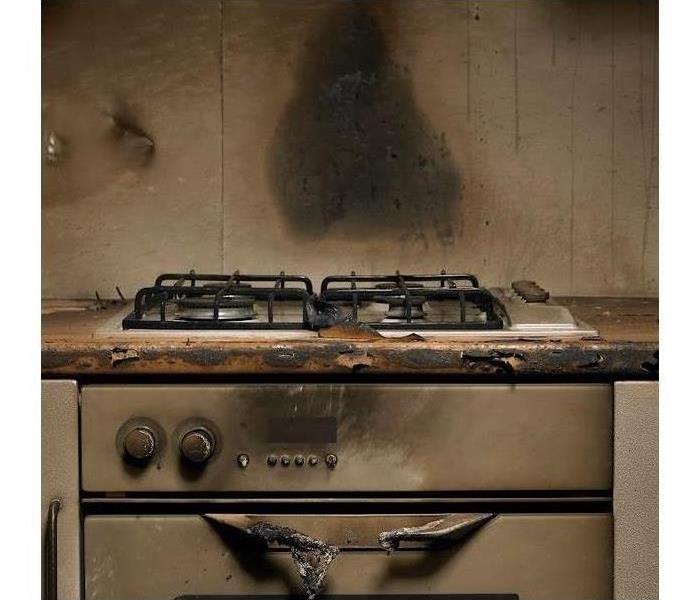 Dealing with a kitchen fire will certainly cause some frustration. Handle the situation with a call to SERVPRO. We are standing by 24/7 for you.
Dealing with a kitchen fire will certainly cause some frustration. Handle the situation with a call to SERVPRO. We are standing by 24/7 for you.
Calling Experts for Fire Restoration in Your Home Puts a Solid Plan into Action for Quality Results
With any kitchen fire, the stovetop is the usual culprit. Whether you had a grease fire or another fire loss, the soot and smoke can be tough to deal with on your own. Instead of going the DIY route, the trained professionals at SERVPRO get to work fast using all of the latest techniques and technology to restore your interior to pre-damage condition.
How Do You Address a Fire Restoration Call?
Once you call us for emergency service, our skilled technicians arrive on the scene to begin the assessment and restoration. After removing all of the fire-damaged materials and debris in your Southern McHenry County kitchen, such as cabinets, lighting, drywall, and appliances, we then begin cleaning soot and smoke particles.
- Wet smoke is generated with lower heat, often coming from burning rubber or plastics. Such smoke residue is often stubborn because it webs and becomes sticky or smears to the touch.
- Dry smoke develops at a higher temperature and is fast-burning, often coming from burned materials like wood and paper. This type of smoke is often easier to clean.
We know that air-quality and foul odors are an issue with any kitchen fire, so we have a range of deodorization techniques that allow us to make your interior, “Like it never even happened.”
- Thermal Foggers, also known as dry fogging, helps to vaporize deodorizers that react on a chemical level with odor-causing residues.
- Air scrubbers are excellent for removing airborne particles and odorous elements from the air.
SERVPRO of Southern McHenry County understands how important it is for you to get your home back to normal quickly after suffering from fire damage in your kitchen. Call us 24/7 at (847) 516-1600 to deploy a team that gets to work fast with specialized restoration services
There's a Fire in Your Home, What Do You Do?
12/7/2021 (Permalink)
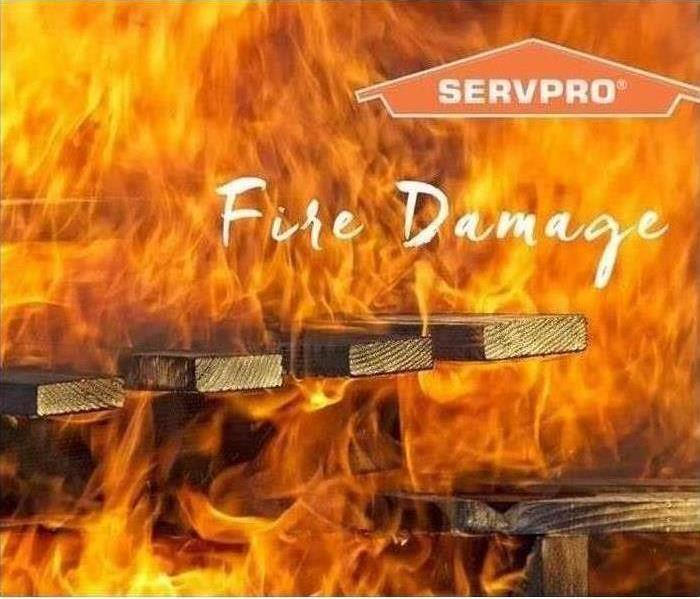 Fire damage can be very devastating, SERVPRO of Southern McHenry County will make sure that you, your home, and your family are taken care of
Fire damage can be very devastating, SERVPRO of Southern McHenry County will make sure that you, your home, and your family are taken care of
Do you know what to do if there is a fire in your house? Check out these steps to ensure you are prepared if a fire erupts in your home:
- Fight the fire or flee?
- Don't attempt to extinguish any fire if there is a threat to your safety. If the fire is small and you know how to use a fire extinguisher, you can attempt to extinguish the fire. You must note that fires can increase in size and intensity in seconds, blocking the exit path can create a dangerous atmosphere.
- The main priority is to get you and your family members out safely.
- Your priority should be to get yourself and your family members out as quickly as possible. Please don't think of picking up your valuables. Timing is very important.
- If you see smoke, crawl to the nearest exit!
- The toxic gases and the super heated air in the smoke makes it more dangerous. Smoke is lighter than air and so it rises above air.
If you experience a fire in your home, call the professionals at SERVPRO of Southern McHenry County at 847-516-1600.
Celebrate Safely This Holiday Season
12/6/2021 (Permalink)
 It is as important to keep safety top of mind with a small family gathering as it is with a large holiday party.
It is as important to keep safety top of mind with a small family gathering as it is with a large holiday party.
In a year when large holiday gatherings may not be possible, fire damage restoration specialists at SERVPRO of Southern McHenry County say to focus on family decorating traditions and more intimate celebrations may take on extra significance. It is as important to keep safety top of mind with a small family gathering as it is with a large holiday party. We all enjoy bringing the glow of the holiday season to our homes with Christmas trees or menorahs and candlelight, but these statistics from the U.S. Fire Administration show how easy it is for home decorating to turn into a home disaster.
- The top three days for home candle fires are Christmas Day, New Year’s Day and New Year’s Eve.
- More than half of the home decoration fires in December are started by candles.
- A heat source too close to the Christmas tree causes one in every four winter fires.
- On average, one of every 52 reported home Christmas tree fires resulted in death.
In addition to exercising caution with candles and heat sources, it is important to follow manufacturers’ guidelines for holiday lighting. According to the National Fire Protection Association, electrical distribution, or lighting equipment was involved in 44% of home Christmas tree fires. Though Christmas tree fires may not be common, they can be devastating to more than the house itself. They can destroy irreplaceable photos, mementos, and family heirlooms and even cost lives. To help keep your holidays bright and your home and family safe, use common sense with candles and tree placement and follow these important home decorating guidelines.
- Only use decorations that are flame-retardant or not flammable.
- Check holiday lights each year for frayed wires or excessive wear.
- Don’t link more than three strands of holiday lights.
In a year when so many of the things we take for granted have changed, we know people will still come together – in person or virtually – to celebrate family and holiday traditions. Stay safe’ has become a common expression in the context of public health, but this holiday season, we urge all Southern McHenry County home and business owners to think about ‘staying safe’ in their homes as they prepare for and enjoy the holiday season.
SERVPRO is an industry leader and provider of fire and water cleanup and restoration services. For more fire prevention and fire safety tips and information about fire and water damage restoration services, call us at 847-516-1600
Should Homeowners Handle Fire Cleanup Themselves?
11/1/2021 (Permalink)
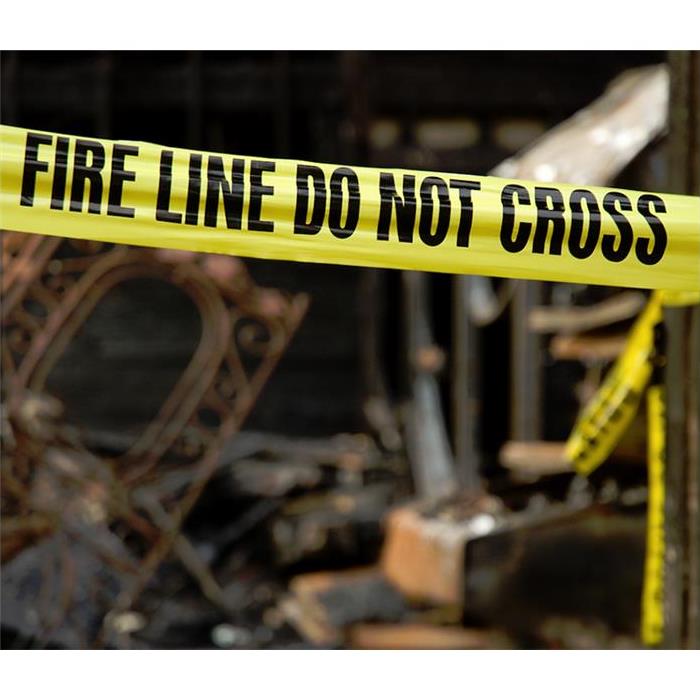 Regardless whether the fire was major or minor, cleanup is an issue. Call our SERVPRO team for a fast response. We are standing by 24/7 for you.
Regardless whether the fire was major or minor, cleanup is an issue. Call our SERVPRO team for a fast response. We are standing by 24/7 for you.
SERVPRO Pros Can Mitigate Fire Damage to Southern Mchenry County Homes
A home can experience significant damage from a fire. Tackling the cleanup on your own, or delaying restoration, can cause secondary damage that may be irreversible. It is critical to call in a professional restoration such as SERVPRO immediately.
Fire Damage Cleanup is Not a DIY Project
When fire damage impacts a home, especially if it gets contained quickly, many people think they can handle cleaning and restoration on their own. But there are many reasons this is not a good idea, including:
- You could inhale smoke residue
- If the structure is weak, it could collapse
- Attempting to clean could cause the soot residue to spread
- Using DIY products can cause more damage
- Insurance may not cover homeowners doing the cleaning
Even after intensive cleaning, smoke odors can linger. Our Green Team has the expertise and equipment to seek out and eliminate the foul odors. We use things like air scrubbers to pull airborne particles and odors from the air. We use a specialized cleaning process that involves agitative cleaning to restore fire damaged services. Everything we do is designed to get you back in your home as quickly as possible. For fire damage cleanup, contact SERVPRO of Southern Mchenry County at (847) 516-1600.
Prevent Fire Damage in Southern Mchenry County IL
11/1/2021 (Permalink)
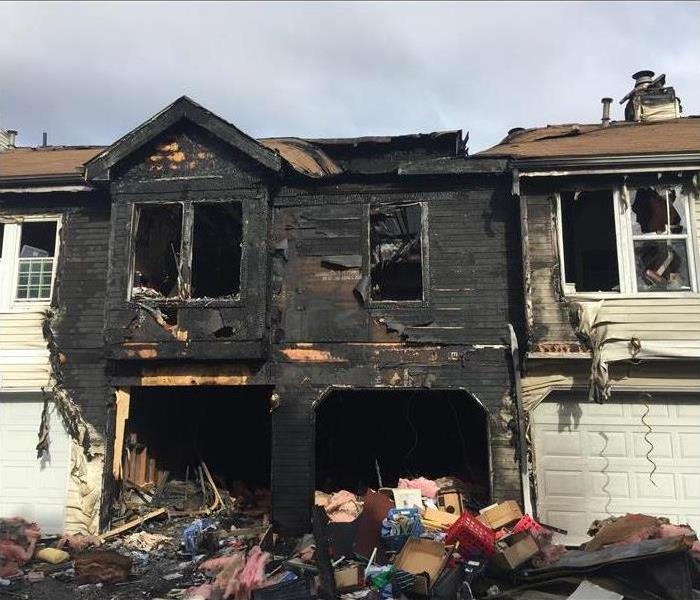 Photo shows the cause of loss area where most of the severe fire damage was contained to in Southern Mchenry County IL
Photo shows the cause of loss area where most of the severe fire damage was contained to in Southern Mchenry County IL
Each day there is a worry that a fire might occur in your home. There is not always a way to prevent a house fire.
Here are some tips to keep in mind to do what you can to prevent a house fire:
1. Test your smoke alarms regularly. Each time change, change the batteries
2. Inspect all heating sources in the home. This includes pilot lights and candles. Make sure all candles are only burning when you are in the room.
3. Maintain and clean your dryer vents. Lint mustn't fill up the dryer vent.
4. If you are cooking, do not leave your kitchen. The most important one is boiling water or frying chicken. It is vital to make sure you keep an eye on whatever you are cooking.
These are a few short steps you can keep in mind when being fire safe in your home.
Check out our website for more details!
Types of Fires and How They Are Extinguished
9/19/2021 (Permalink)
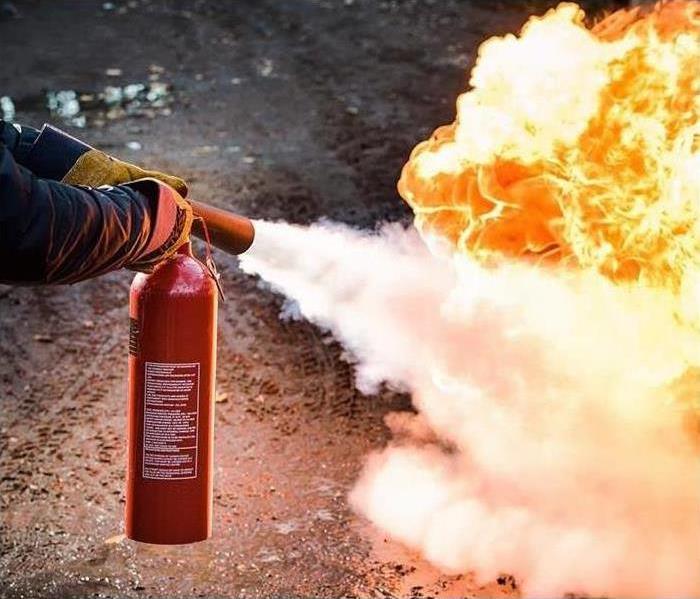 Knowing the type of fire you are trying to extinguish is essential for safely attempting to put it out and can help avoid making the fire worse
Knowing the type of fire you are trying to extinguish is essential for safely attempting to put it out and can help avoid making the fire worse
According to the U.S. Fire Administration, there were approximately 1,345,500 fires nationwide in 2015. As a homeowner or property manager, being aware of the different types of fires and how they are extinguished can help you to quickly resolve a fire incident, avoid making it worse, and even determine when the risks are too high for any attempt at extinguishing the flames. In the event of any fire, your safety and health should be your number one priority at all times. If you are concerned about your safety at any point, vacate the property, keep a safe distance, and wait for your local fire department to arrive. The types of fires are generally split into the 5 classes listed below.
Class A - Ordinary Combustible Fires
This common type of fire happens when materials are heated to their ignition temperature. Heat, oxygen, and fuel will allow a combustible fire to continue burning. Rubber, plastic, textiles, wood, paper and organic carbon-based compounds are a few of the materials that can be involved in these types of fires.
Combustible fires are usually the most simple to extinguish since spraying with water will cool the flames and source material. By removing the supply of heat, the fire is left without the essentials needed to burn. A water-based or foam based fire extinguish is recommended for Class A fires.
Class B - Flammable Liquids
Any liquid substance that has an ignition temperature below 100°C is classified as a flammable liquid. These liquids burn easily due to having a low flashpoint ( the temperature of a substance where enough vapor to be ignited is released). If a spark, flame, or any other source of ignition is applied to a flammable liquid, they can burn at any temperature. Types of flammable liquids include, but are not limited to, petrol, kerosene, alcohol, solvents, and paints.
When attempting to extinguish a Class B fire, it is important that you DO NOT use water to put the fire out. Splashing water can cause the flammable liquid to spread, spreading the fire along with it. Instead, smother the flames using a foam extinguisher. It is also important to note that Class B fires produce a thick and black toxic smoke, so avoiding the fire and waiting for the professionals may be the best route.
Class C - Flammable Gases
Butane, propane, and petroleum are a few flammable gases that have the potential for creating explosions if triggered by a spark. These fires are amongst the most dangerous and only need about a 5% concentration of flammable gas in the air to burn.
These fires should always be left to your fire department. Once on scene, they will have to isolate the fire’s gas supply and then use dry powder extinguishers. Most other extinguishers are ineffective against Class C Fires.
Class D - Metal Fires
Metals are good conductors and most require a lot of heat to ignite. Certain types of metals can burn if ignited. Metal shavings and powders pose a higher fire risk than solid masses of metal. Alkali metals such as potassium, magnesium, and sodium can burn when in contact with air and water. Therefore, spraying water or foam onto metal fires will increase the intensity of the flames and can potentially cause explosive reactions sending pieces of burning metal in all directions.
When dealing with a Class D fire, the safest approach is usually to allow the fire to burn out on its own. These type of fires tend to occur in industrial properties with large amounts of burning metal and an increased chance of explosions. Class D fires have a tendency for producing large amounts of ash, which builds up and starves the fire’s supply of oxygen. For metal fires that are spotted early, special type D powder fire extinguishers can be effective. Just make sure to check that they are the specific dry powder type intended for use on metal fires.
Electrical Fires
Electrical fires do not have a class of their own and are designated to Class C in the United States. However, they have their own fire safety requirements and are important to mention. These fires can be caused by short circuits, overloaded switchboards, faulty equipment and damaged wiring.
Before attempting to extinguish an electrical fire, it is important to isolate its electrical supply as quickly as possible. Water and foam are both conductors for electricity, so even after isolation, it is not safe to use them as extinguishers. The only types of extinguishers recommended for safely addressing electrical fires are carbon dioxide and dry powder fire extinguishers.
Class F - Cooking Oil Fires
Fires that involve cooking oil and fats are classified as Class F. These fires are common in homes, businesses and professional kitchens. They pose a very difficult challenge to extinguish, due to the high temperatures involved. Simply trying to cool the fire with water will not work. In fact, using water on a burning pan is likely to cause a rapid spreading out of the flames, making the fire worse and potentially injuring anyone in its vicinity.
For this reason, special fire extinguishers have been developed to address Class F fires. Wet chemical extinguishers contain a formula which cools the fire and then mixes with the oil to seal the surface and prevent re-ignition.
Fire Damage Restoration
SERVPRO of Southern McHenry County does not extinguish fires. In case of a fire emergency, please contact your local emergency services and fire department for assistance. If you have suffered from fire damage to your property, give us a call at 847-516-1600. Our phone lines are open 24 hours to assist you and our skilled technicians can help you assess the extent of the damage to get the fire damage restoration process going.
Where Do I Start the Cleanup After a Kitchen Fire in Southern McHenry County?
7/21/2021 (Permalink)
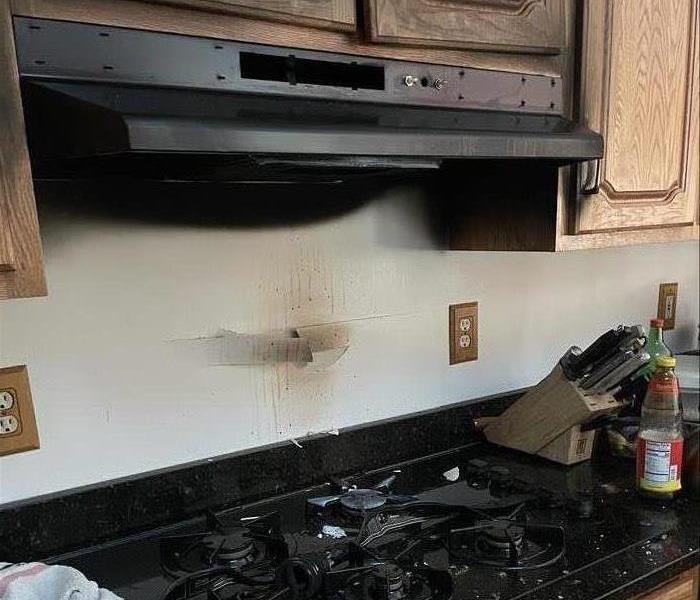 Fire damage can displace your family if not taken care of properly. Contact SERVPRO for mitigation.
Fire damage can displace your family if not taken care of properly. Contact SERVPRO for mitigation.
Calling Experts for Fire Restoration in Your Home Puts a Solid Plan into Action for Quality Results
With any kitchen fire, the stovetop is the usual culprit. Whether you had a grease fire or another fire loss, the soot and smoke can be tough to deal with on your own. Instead of going the DIY route, the trained professionals at SERVPRO get to work fast using all of the latest techniques and technology to restore your interior to pre-damage condition.
How Do You Address a Fire Restoration Call?
Once you call us for emergency service, our skilled technicians arrive on the scene to begin the assessment and restoration. After removing all of the fire-damaged materials and debris in your kitchen, such as cabinets, lighting, drywall, and appliances, we then begin cleaning soot and smoke particles.
- Wet smoke is generated with lower heat, often coming from burning rubber or plastics. Such smoke residue is often stubborn because it webs and becomes sticky or smears to the touch.
- Dry smoke develops at a higher temperature and is fast-burning, often coming from burned materials like wood and paper. This type of smoke is often easier to clean.
We know that air-quality and foul odors are an issue with any kitchen fire, so we have a range of deodorization techniques that allow us to make your interior, “Like it never even happened.”
- Thermal foggers, also known as dry fogging, helps to vaporize deodorizers that react on a chemical level with odor-causing residues.
- Air scrubbers are excellent for removing airborne particles and odorous elements from the air.
SERVPRO of Southern McHenry County understands how important it is for you to get your home back to normal quickly after suffering from fire damage in your kitchen. Call us 24/7 at (847)-516-1600 to deploy a team that gets to work fast with specialized restoration services.
How Long Do You Have to Escape a House Fire?
12/17/2020 (Permalink)
How long do you have to escape a house fire? It's way less time than you think.
Everyone knows not to dawdle if their house is on fire, but you may believe you have some time to make a safe exit. Well, think again.
Gail McGovern, the president of the Red Cross reveals that you only have two (just two!) minutes to get out of your home before you might get stuck in the flames. This is because it only takes about five minutes for a fire to consume your entire house. And with one in seven people dying in a house fire each day, there's little room for error.
Practicing fire safety certainly requires vigilance, but it doesn't take too much effort to avoid a tragedy. First, make sure you have smoke alarms in your home (5 million American homes don't). You need one in every bedroom, one outside every sleeping area, and at least one on every floor. Make sure the detectors are working and refresh their batteries when you change the clocks for the beginning and end of Daylight Saving Time.
Also, it's important to practice fire drills with your family. You should go over possible routes to get out of your house fast, and consider getting escape ladders for any rooms on upper floors. Choose a meeting place outside that's a safe distance from your home.
And of course, you should take steps to prevent fires from happening in the first place. Watch the video to learn which common mistakes you might be making.
When fire and water damage strikes, a fast response is critical. We’re dedicated to responding immediately, day or night, to your Southern McHenry County home or business. A faster response helps to prevent secondary damage and to reduce cost.
We are available to assist you 24/7/365.
Holiday Decoration Safety Tips
12/2/2020 (Permalink)
If your home, like millions of other households in the U.S., includes a Christmas tree and festive holiday decorations, you should be aware that the breathtaking beauty of the decorations also comes with a fire risk. That is why Rick Isaacson, CEO of SERVPRO Industries, Inc., is offering helpful tips to local residents.
“Basking in the glow of a warm fire or relaxing in a festively decorated home or office building may actually present a formula for a hazardous situation if you don’t take the proper precautions,” Isaacson said. “We want to show local residents how to keep their night before Christmas from becoming a nightmare before Christmas!”
Candles and Christmas trees have been reported to be two of the contributing factors of fires during the winter months. According to the U.S. Fire Administration, Christmas trees account for an estimated 200 fires annually and cause more than $6 million in property damage. Candles alone cause an estimated 15,600 fires each year, causing 1,270 injuries and more than $539 million in property damage. December is the peak month for candle fires, and Christmas is the peak day.
The following are a few tips for the members of the local community to consider when putting up and maintaining their holiday decorations:
- Do not overload power outlets with holiday lights. Pay close attention to the manufacturer’s instructions on the number of lights you can string together.
- Consider using battery-operated flameless candles.
- Be careful not to splatter wax when extinguishing a candle.
- Use flashlights instead of candles for emergency lighting.
- Do not purchase a Christmas tree that is dry or dropping needles excessively. Be sure to water your Christmas tree regularly.
- Do not use strings of lights that are worn, frayed, manually spliced or broken.
- If you purchase an artificial tree, be sure it is labeled fire-retardant.
- Do not link more than three light strands unless the directions indicate it is safe. Connect strings of lights to an extension cord before plugging the cord into the outlet. Be sure to periodically check the wires; they should not be warm to the touch.
“While holiday decorations can provide plenty of charm and cheer with assorted bright lights, Christmas trees and life-size Santa Claus figures, it is our responsibility to inform residents of potential dangers. We, too, want to see the glowing lights that are symbols of the winter holiday season, but we also want the community to be safe.” Isaacson said. “No matter what local residents’ reasons are for celebrating this month, we want everyone to enjoy the month of December safely.”
Check us out on Facebook!
Fire or Water Damage? Let SERVPRO be your hero!
Smoke Alarms DO Save Lives in Southern McHenry County
11/1/2020 (Permalink)
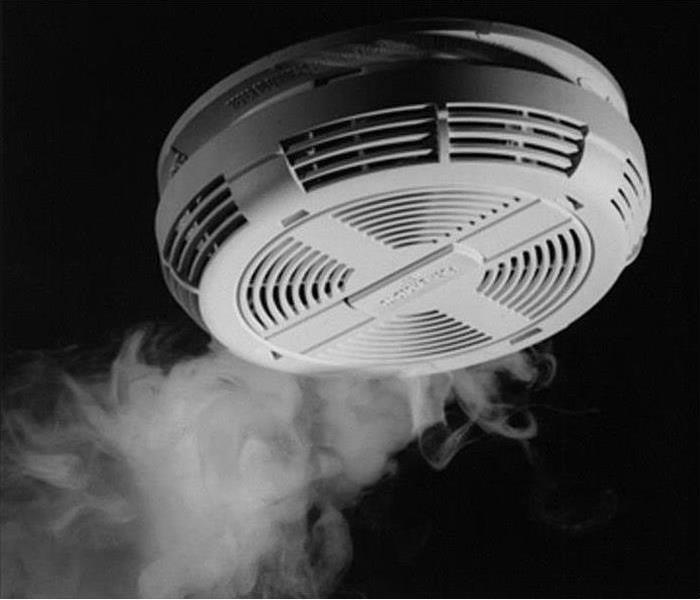 Make sure YOUR smoke alarm is effectively operating on a regular basis!
Make sure YOUR smoke alarm is effectively operating on a regular basis!
Smoke alarms play a vital role in saving lives and, when properly installed, can reduce the risk of fire injury in half.*
The National Fire Protection Association recommends smoke alarms be installed in every bedroom, outside all sleeping quarters and on every level of the house. Business owners should consult the local Fire Marshall to ensure specific building fire codes and smoke detector requirements are met.
Smoke alarms work best when paired with a fire escape plan. A plan allows your family, employees, or clients to escape quickly and safely in an emergency situation.
Review the following tips regarding smoke detector installation and maintenance. For more on emergency preparedness, contact SERVPRO of Southern McHenry County
- Install smoke alarms on every level of the home, including the basement
- Smoke alarms should be installed away from the kitchen to prevent false alarms. Generally, they should be at least 10 feet from a cooking appliance
- Test smoke alarms at least once a month using the test button
- Replace batteries in all smoke alarms at least once a year. If an alarm "chirps," the battery is low and should be replaced right away
- Replace all smoke alarms when they are 10 years old
JUST THE FACTS:
- Three out of five fire deaths occur in homes with no smoke alarms or when the alarms are not working
- Smoke alarm failures usually result from missing, disconnected, or dead batteries
- More than one-third (37 percent) of home fire deaths result from fires in which no smoke alarms are present
- The risk of dying in a home fire is cut in half in homes with working smoke alarms
Even if a fire should occur in your Southern McHenry County home, call SERVPRO of Southern McHenry County for any assistance you may need – 847-516-1600.
*Statistics and tips provided by National Fire Prevention Association
How to Properly Use Space Heaters
11/1/2020 (Permalink)
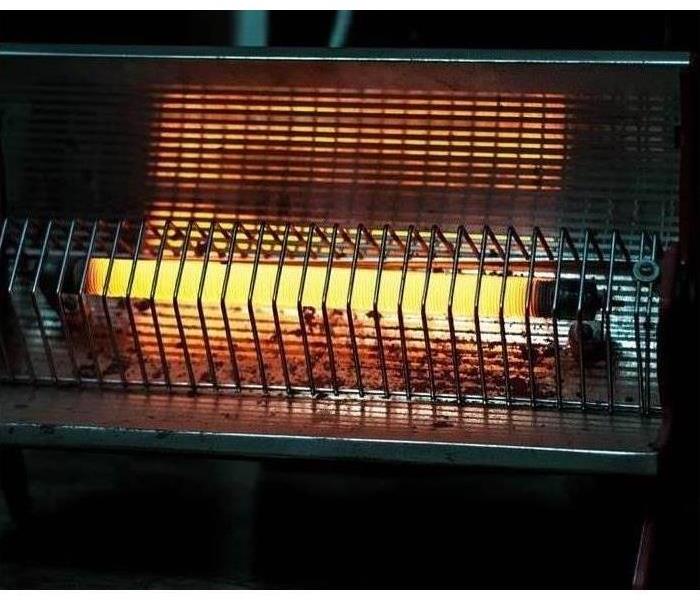 When used properly, space heaters can be a big help in cold weather!
When used properly, space heaters can be a big help in cold weather!
During the winter, your central heating system works overtime. Sometimes you may only need to heat one room and give your main heater a break by using a portable space heater - an effective option, and one that can save you some money, too.
These units are high-wattage appliances, though, and they do have the potential to cause fires in your home if not used correctly. Today, we are sharing some tips on the proper use of space heaters so that you and your loved ones can stay safe.
When Purchasing A Space Heater
- Label. Check to see that your heater is listed by a qualified testing laboratory.
- Smart Heaters. Purchase one with a sensor that will shut it off automatically if it overheats or gets tipped over.
- Preparation. Install smoke detectors in your home, as well as carbon monoxide alarms. These need to be tested monthly.
- Inspection. Inspect your heater and its cord and plug. Do not use it if you think it could be defective.
Setting Up Your Space Heater
- Placement. Place your heater on a solid flat surface, and make sure it’s at least 3 feet from anything flammable. If it is being used in the garage or workshop, keep it away from any paint, oil, and gas cans.
- Hazards. Don’t place the heater on furniture or cover it up, and be careful of high-traffic areas and doorways, where someone could trip over it and get burned. Never run a power cord under carpets, rugs, or furniture.
- Plugs. Plug your heater into an outlet directly instead of using an extension cord or power strip. Make sure the plug fits well and is the only plug in the outlet.
- Water. Always keep your heater away from water, and if you’re wet - don’t touch it.
Running Your Space Heater
- Check. Check your heater often to make sure that the plug, cord, outlet, or faceplate isn’t hot. If it is, stop using it immediately, and remember that a hot cord may mean it is defective and could ignite a fire.
- Time. Don’t run your heater 24/7. It isn’t made to work for long periods of time.
- Turn it off. Never leave a space heater unattended or in a child’s room, and turn it off while you are sleeping.
Terms You May Hear After A Fire
9/22/2020 (Permalink)
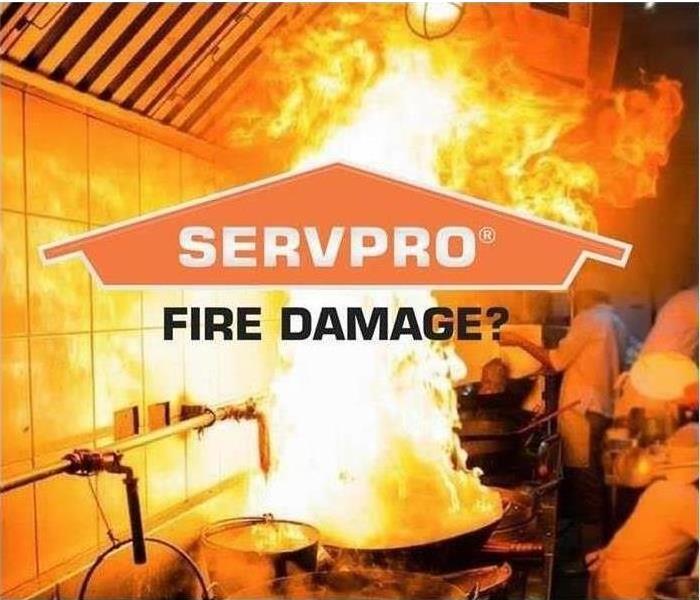 Kitchen Fire
Kitchen Fire
Call SERVPRO of Southern McHenry County for fire and water cleanup and restoration.
Industry Terms For Fire Damage
If you experience a fire, whether as a homeowner or in the commercial environment, you may hear many different terms you’re not familiar with. We’d like to familiarize you with some of the terms we use in the restoration industry, so that you can better understand what’s being said and what’s happening.
SERVPRO of Southern McHenry County thrives on transparency and open communication for the Property Owner to better understand the restoration process. We will always communicate with you throughout the process, so that you feel comfortable with each and every step.
Fire Damage: This is a general term meaning that fire was the source of the loss.
IICRC Training and Certification: The Institute of Inspection Cleaning and Restoration Certification. The (IICRC) certifies and sets the standards for the cleaning and restoration industries. SERVPRO of Southern McHenry County is an IICRC certified firm.
Stabilizing the Structure: This is typically done by the Fire Department after fighting the fire. We need to be sure the structure is safe for our technicians to begin the cleanup and remediation process.
Roof Tarping: The Fire Department will often vent the roof of a structure fire to help in their efforts to control and extinguish the blaze. To vent the roof they use an ax or saw to cut a hole in the roof. We use a thick, weatherproof tarp to cover any holes in the roof to minimize secondary damage from precipitation or animals.
Board-Up: We use strong plywood to cover any broken windows or doors that cannot be locked. This is done to preserve the structure and to keep the home safe from possible break-ins and exposure to the outside environment.
Secondary Damage: This is the damage created by the corrosive nature of substances released by the heat and fire. Often the secondary damages can account for the majority of damage to a home or business.
Pre-Loss Condition: This means to return the property to its original state before the fire or water damage occurred. “Like it never even happened.”
Demo or Demolition: When material has experienced permanent damage and cannot be cleaned or restored, it is then removed and disposed of but ONLY with the owners permission.
Air Scrubber: A portable filtration system that removes particles, gases and /or chemicals from the air within a given space.
HEPA Filter: HEPA stands for High Efficiency Particulate Absorber. An air cleansing machine.
Structural Damage: This is the damage that affects the core-integrity of your home or business. These areas consist of your roof, framing and load-bearing walls.
Contents: Imagine turning your house upside down and taking off the roof, anything that would fall out is considered contents. Furniture, clothing, and personal items.
Pack-out: When necessary our crews carefully remove all contents and move them to our warehouse where they are inventoried, cleaned and restored. This allows for better access to clean and restore the home and eliminates the possibility of secondary damage during the restoration process.
Fireworks Safety
7/6/2020 (Permalink)
 Fourth of July Fireworks
Fourth of July Fireworks
Fireworks are synonymous with our celebration of the Fourth of July. Yet, the thrill of fireworks can also bring pain and damage. On average, 230 people go to the emergency room every day with fireworks-related injuries in the month around the July 4th holiday. Not to mention countless number of fires started by fireworks, causing structural and vehicle damage. As we approach the Fourth of July holiday weekend, The National Council on Fireworks Safety encourages consumers to review all safety tips before puchasing and using fireworks.
First and foremost, know and obey all local laws regarding the use of fireworks. In many cities, fireworks are illegal to use.
* know your fireworks; read labels and warnings
* an adult should supervise all fireworks activities
* wear safety glasses when shooting fireworks
* use fireworks in a clear area, away from buildings and vehicles
* never relight a "dud" firework; wait 20 minutes then soak it in a bucket of water before discarding
*always have a water source nearby
The safest way to enjoy fireworks is to leave them to the professionals. Our communities have several opportunities to view professional fireworks displays. What better way to celebrate but to sit back and enjoy the show!
Happy Fourth of July! Enjoy the long weekend and be safe!
Habits That Cause House Fires
2/24/2020 (Permalink)
SERVPRO of Southern McHenry County has the specialized fire restoration training and experience to quickly restore your home to pre-fire condition.
8 Bad Habits That Could Burn Your House Down
Your everyday routine could be putting your family at risk.
Fire safety is a hot-button topic (pun intended) — and rightly so. During a recent five-year study by the National Fire Protection Association (NFPA), U.S. fire departments responded to 1,000 home fires every day, on average. That's 42 every hour, causing roughly $228 in damage each second.
"The majority of home fires can be prevented by taking some very simple steps," says Lorraine Carli of the NFPA. Start today by considering all of the little things you do that can put you at big risk.
- Crowding appliances together
"When you don't leave space around electrical appliances, you're not allowing the heat they generate to dissipate," says Rachel Rothman, Technical Director at the Good Housekeeping Institute. All major appliances should be plugged directly into a wall outlet — rather than using extension cords or power strips to clump them in the same area — according to Carli. "More than one heat-producing appliance in an outlet at a time risks overloading the wiring, putting you at risk for an electrical fire.
Another safety tip: "Sign up to get recall notices on your major appliances at Recalls.gov, " advises Rothman. "Every now and again products are recalled that have been found to be potentially dangerous due to overheating."
- Walking away from food cooking in the kitchen
Cooking (chiefly, unattended cooking) is by far the leading cause of home fires. "It only takes a few seconds for abandoned cooking to catch fire," says Carli. Frying is the riskiest, according to the U.S. Fire Administration. You may want to avoid the technique on Thanksgiving: it's the top day for home cooking fires.
- Daisy-chaining extension cords
"Connecting cords overloads them, which can cause a short circuit that can result in a fire," says Carli, noting that extension cords are only meant to be a temporary solution. "If you need more outlets, seek a qualified electrician to install some."
And never assume that your power strip has built-in surge protection. "In general, power strips are not designed to regulate power flow or block surges," says Rothman. Plugs that do not have a UL, CSA-US or ETL-US mark should be avoided.
- Making do with damaged or worn out cords
Using compromised cords can cause electric shock as well as increase your fire risk if heat from the wires comes in contact with anything that can burn, says Carli, who recommends replacing any cords. As Bruce Springsteen sings, "you can't start a fire without a spark." And in less than 30 seconds, the USFA reveals, "a small flame can get completely out of control and turn into a major fire."
- Leaving home with an electrical appliance running
"You should never have an appliance on that is not properly tended to, especially if leaving the house," says Rothman. The exception? Crockpots. "They're OK," says Carli, noting that "the food does not get hot enough or boil to cause a big fire concern."
- Ignoring the lint that needs to be cleaned out from the dryer
According to the USFA, 2,900 home clothes dryer fires are reported each year and cause $35 million in property loss. Thirty-four percent of those blazes were caused because the homeowner didn't clean the dryer. "Lint that collects on the filter, around the drum, and in the vents, can catch fire from the heat of the dryer," says Carli. "Without cleaning, the lint builds up and then the heat can't escape." Clean your lint filter regularly, but also check your dryer hose for lint clogs at least once a year.
- Leaving a lit candle unattended
It sounds simple but bears repeating considering how much damage even a single votive can do. "Candles can be blown over or knocked over by pets," says Carli. "Use sturdy holders and extinguish them when you leave the room."
- Putting off cleaning the chimney
"Creosote, the oily substance that builds up when you burn things in your fireplace, is a leading cause of chimney fires," says Carli. "Have chimneys inspected on a yearly basis and cleaned as needed." But never toss fireplace ashes in the trash before they're 100 percent cool (and that could take a few days). Rothman advises, "Put water on the ashes to make sure they are really out."
When fire and water damage strikes, a fast response is critical. We’re dedicated to responding immediately, day or night, to your Southern McHenry County home or business. A faster response helps to prevent secondary damage and to reduce cost.
We are available to assist you 24/7/365. Call 847-516-1600.
Holiday Decoration Safety Tips
12/20/2019 (Permalink)
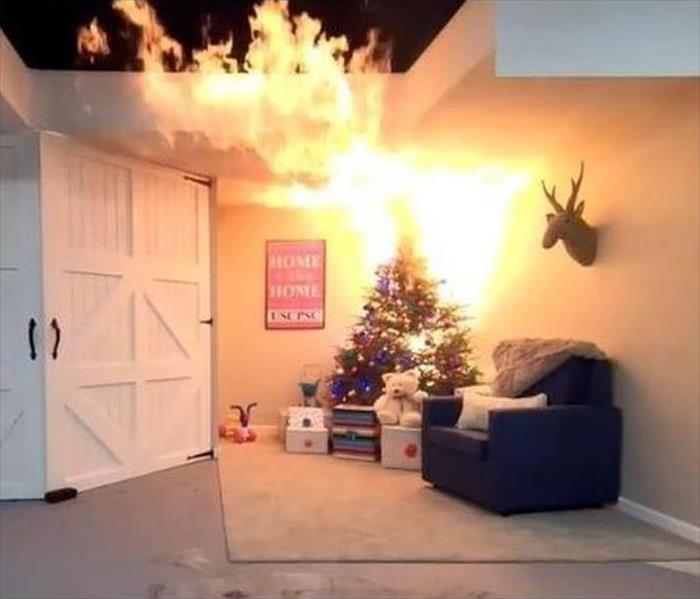 Simple Christmas tree mistake that could cause a devastating fire
Simple Christmas tree mistake that could cause a devastating fire
If your home, like millions of other households in the U.S., includes a Christmas tree and festive holiday decorations, you should be aware that the breathtaking beauty of the decorations also comes with a fire risk.
Basking in the glow of a warm fire or relaxing in a festively decorated home or office building may actually present a formula for a hazardous situation if you don’t take the proper precautions, SERVPRO wants to show local residents how to keep their night before Christmas from becoming a nightmare before Christmas!
Candles and Christmas trees have been reported to be two of the contributing factors of fires during the winter months. According to the U.S. Fire Administration, Christmas trees account for an estimated 200 fires annually and cause more than $6 million in property damage. Candles alone cause an estimated 15,600 fires each year, causing 1,270 injuries and more than $539 million in property damage. December is the peak month for candle fires, and Christmas is the peak day.
The following are a few tips for the members of the local community to consider when putting up and maintaining their holiday decorations:
- Do not overload power outlets with holiday lights. Pay close attention to the manufacturer’s instructions on the number of lights you can string together.
- Consider using battery-operated flame less candles.
- Be careful not to splatter wax when extinguishing a candle.
- Use flashlights instead of candles for emergency lighting.
- Do not purchase a Christmas tree that is dry or dropping needles excessively. Be sure to water your Christmas tree regularly.
- Do not use strings of lights that are worn, frayed, manually spliced or broken.
- If you purchase an artificial tree, be sure it is labeled fire-retardant.
- Do not link more than three light strands unless the directions indicate it is safe. Connect strings of lights to an extension cord before plugging the cord into the outlet. Be sure to periodically check the wires; they should not be warm to the touch.
While holiday decorations can provide plenty of charm and cheer with assorted bright lights, Christmas trees and life-size Santa Claus figures, it is our responsibility to inform residents of potential dangers. We, too, want to see the glowing lights that are symbols of the winter holiday season, but we also want the community to be safe. No matter what local residents’ reasons are for celebrating this month, we want everyone to enjoy the month of December safely.
Check us out on Facebook! https://www.facebook.com/SERVPROofsmchenryco/
Fire or Water Damage? Let SERVPRO be your hero!
Source of Picture: U.S. Consumer Product Safety Commission CPSC.gov
Working with Insurance Adjusters After a Fire
12/20/2019 (Permalink)
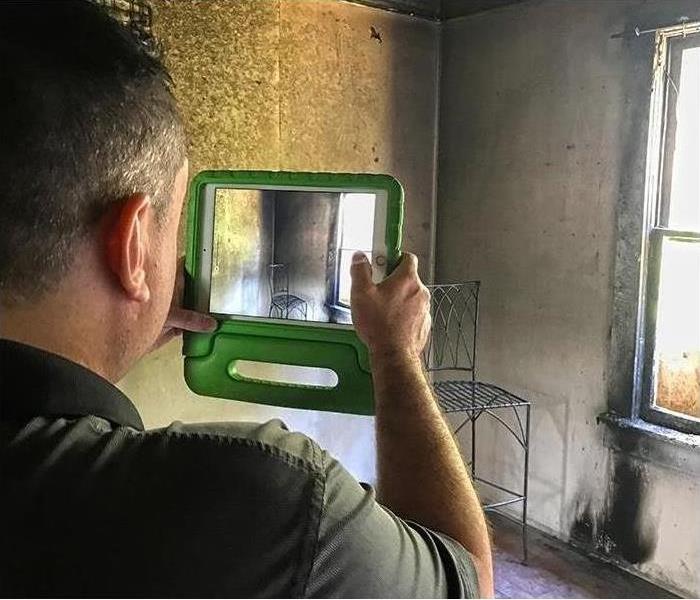 Taking photos of the damage during an inspection helps for building an estimate and even providing documentation to your adjuster.
Taking photos of the damage during an inspection helps for building an estimate and even providing documentation to your adjuster.
Experiencing a fire in your Southern McHenry County home is a possibility that no homeowner wants to consider, however, it is a possibility that occurs more frequently than you may think. There are many causes of fires and they can occur any day, without warning, and cause an overwhelming amount of damage and prolonged effects on your property. Aside from the stress of dealing with a fire itself, the aftermath and process of restoring your property can be equally stressful as well.
The Process with Your Insurance Adjuster
SERVPRO of Southern McHenry County knows how stressful these situations can be and works to make the fire damage restoration process as smooth as possible. Not only do we work to communicate clearly and constantly with you throughout the actual restoration process, but we also communicate with your insurance company and adjuster to help determine which areas of your property require professional restoration services and what items are a loss. Our team works closely with you and your adjuster to make the right determinations and provide the necessary information to get your claim going as quickly as possible.
Fast and Comprehensive Estimate
Working quickly and accurately to provide you and your adjuster with an estimate plays a crucial part in expediting the process of your claim. Our team inspects all of the damage to your home, visible and nonvisible, in order to determine the best course of action for restoration and the amount of equipment, personnel, and time needed to complete the project.
Fire Damage Restoration Process
Once your claims are filed and you are covered by your insurance company, our fire restoration team can get started with the fire damage restoration process and work to get your property restored and functional once again. The length of this process can fluctuate based on the severity of the fire and components affected.
Our crew works diligently to make sure the appropriate measures get taken to overcome all of the damage that your home experienced from the recent fire. If you are facing fire damages in your home, you can trust SERVPRO of Southern McHenry County professional team to help you get going in the right direction. Give us a call at any time or day at (847) 516-1600.
Tips for Preventing Holiday Fires
11/1/2019 (Permalink)
 Deep Frying Turkey Danger
Deep Frying Turkey Danger
Tips for Preventing Holiday Fires
Quick Tip: Make sure to only display candles in populated areas of the home and blow them out when leaving the room.
Statistics highlight the need for preparation and caution in holiday decorating and entertaining.
The approaching holiday season brings traditions, parties, shopping, entertaining – and potential danger, according to the restoration specialists at SERVPRO.
The latest statistics available from the National Fire Protection Association (NFPA) show the holidays are a high-risk time for home fires. Christmas trees are responsible for 240 home fires each year, and other holiday decorations are the cause of another 1,170 fires. Thanksgiving Day sees almost a threefold increase in cooking-related fires; cooking fires are almost twice as likely to happen on Christmas Day as on non-holidays.
“No one wants to think about the possibility of losing their home, and even more tragically, lives because of a fire during the holidays,” said Rick Isaacson, Executive Vice President of SERVPRO Industries, Inc. “But statistics show, it’s important to be aware of the increased risk seasonal decorating, entertaining and cooking can cause during the holidays.”
Isaacson reminds homeowners that prevention and common sense can help keep homes and families safe during the holidays and throughout the year. Here are some sobering facts about holiday fires and tips to help keep your home, friends and family safe throughout the holiday season.
Christmas Tree Fire Facts
- 33% of tree fires are caused by electrical problems; 13% involve decorative lights.Check wiring on lights for breaks and wear. Replace worn strings and don’t exceed manufacturer guidelines for connecting multiple strands of lights. Don’t leave tree lights plugged in when you are away from home or when you go to bed.
- 42% occur on the 12 days from December 23 through January 3. Keep live trees well watered to reduce the chance of a fire.
Holiday Decoration Fire Facts
- 45% of all holiday fires involve candles; that number rises to 56% in December. Use flameless candles. If you do use traditional candles, burn them in sturdy candleholders, well away from drapes and other flammable materials, and never leave them unattended or allow them to burn down to less than one inch in length.
- 48% of all decoration fires start because the decoration is too close to a heat source.Keep all decorations away from heat sources like radiators, portable heaters, fireplaces, etc.
Cooking Fire Facts
- Cooking fires on Thanksgiving Day exceed the daily average by 272%. Supervise items on the stovetop. 58% of kitchen fires involve ranges; homes with electric cooktops have a higher risk of fire than homes with gas cooktops.
- Cooking fires on Christmas Day and Christmas Eve exceed the daily average by 96% and 89% respectively. Keep flammable items – potholders, packaging, wrapping, wooden utensils, loose clothing – away from the stovetop. And, don’t let lack of sleep or alcohol consumption affect your ability to concentrate on preparing the meal.
Click here for original article.
A home fire can have devastating physical and mental repercussions. Instead of feeling helpless and wondering where to turn next, use this guide to help you recover quickly and return to normal as soon as possible.
If you have experienced a home fire in the McHenry County area and are in need of fire damage restoration services, call SERVPRO at (847) 516-1600.
Source: SERVPRO.com
Fire and Smoke Damage Clean Up Tips
9/1/2019 (Permalink)
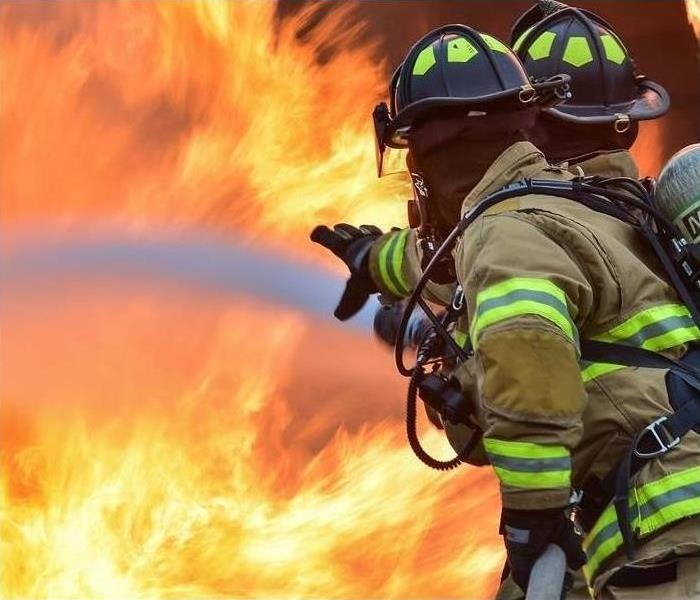 Fire Fighter Dealing With Fire
Fire Fighter Dealing With Fire
Fire and Smoke Damage Clean Up Tips
Damage can come in all forms including fire and smoke damage, and water damage. If you don’t act immediately, you can be faced with additional expenses to fix that damage. We have compiled a list of tips you can enact when facing such damage. Today we are going to focus fire and smoke damage.
- Call SERVPRO. Some by-products can cause etching which is irreversible fairly quickly.
- Do not touch anything that has been damaged with your bare hands. Your hands carry oil which can cause additional damage.
- Open up the house and air out any smoke damage, if the outside temperature is warm.
- Do not wash any of the walls that have smoke/fire damage. The wrong cleaning component can cause more damage.
- Clean off your Formica, chrome, porcelain or aluminum fixtures to prevent permanent tarnishing.
- Call a professional to clean up any upholstered furniture and carpets. Don’t clean them yourself.
- Keep away from anything and everything electronic until they have been checked out by and cleared by a professional.
- Replace your air filter on your furnace if you use forced air.
- If your ceiling is wet, do not use any of the fixtures.
- Throw away all food packages that have been opened.
- Any clothing that has been tarnished, send to a professional for cleaning.
- Clean out the refrigerator/freezers and keep the doors open, if the electricity is off.
Have Questions about Fire, Smoke, or Soot Damage?
Call SERVPRO of Southern McHenry County Today – (847) 516-1600
Cleaning Different Types of Smoke and Soot in Cary/Algonquin/Lake In The Hills Home
7/25/2019 (Permalink)
 SERVPRO techs cleaning Soot from a Ceiling
SERVPRO techs cleaning Soot from a Ceiling
When a fire occurs in your Southern McHenry County home the heat and flames are not the only fire damage causing problems to be concerned about. Smoke generated from the blaze burning structural materials and other components can travel throughout an entire home and ruin its contents. Residue from the smoke can permanently stain contents and building materials requiring them to be replaced. In some cases, it is possible to salvage contents and materials by cleaning and removing soot residues. The level of difficulty for doing so is contingent on the type of soot that is present in the property following the fire.
Wet Smoke Versus Dry Smoke
The length of time and overall clean ability of soot strongly depends on how wet or dry the smoke that caused the damage was. Dry smoke is a result of the blaze burning natural materials quickly and with a significant supply of oxygen. Wet smoke occurs when a fire burns synthetic materials at a slow pace with very little oxygen. It is extremely common for a fire to create both types of smoke while burning.
The easiest soot to clean is caused by dry smoke. SERVPRO of Southern McHenry County uses dry sponges to wipe dry soot off and also can clean it using water-based chemicals. As an additional step, it is very helpful to vacuum carpets and fabrics to remove loose soot and debris. Removing soot from smoke that is too wet, requires much more aggressive cleaning methods that can be extremely difficult or even impossible in some cases.
Smoke Damage from Protein Fires
A large percentage of kitchen fires have a protein fuel source. Protein types of fuels that are commonly burned as a source include meat, poultry, and fish. These proteins produce smoke that leaves behind a residue, which is usually yellow or amber in color. These residues create a foul odor and must be fully cleaned in order for the smell to be removed. Some of this residue cannot be seen but will still cause a foul odor. Therefore, it is necessary to clean the property thoroughly in order to remove the odor completely.
Smoke Damage Cleaning and Odor Removal Services
If you have experienced a fire in your property, SERVPRO of Southern McHenry County is a professional fire restoration company that can help you restore your property, clean soot, and remove odor caused by smoke. We work closely with you and your insurance adjuster to make this stressful situation as smooth as possible. Give us a call 24/7 at 847-516-1600 to get started!
Fire Safety Saves Lives
2/28/2019 (Permalink)
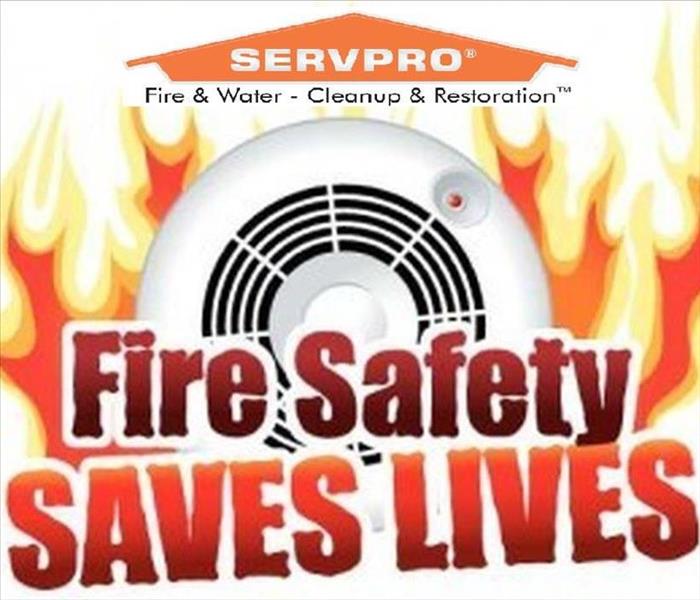 Fire Safety Saves Lives
Fire Safety Saves Lives
Fire Safety
Did you know that if a fire starts in your home you may have as little as two minutes to escape? During a fire, early warning from a working smoke alarm plus a fire escape plan that has been practiced regularly can save lives. Learn what else to do to keep your loved ones safe!
SERVPRO of Southern McHenry County encounters a lot of fires that ended with everyone safely out of the vicinity thanks to smoke detectors that end up looking like this.
Follow these tips from the American Red Cross to make sure you and your loved ones stay safe:
- Install smoke alarms on every level of your home, inside bedrooms and outside sleeping areas.
- Test smoke alarms every month. If they're not working, change the batteries.
- Talk with all family members about a fire escape plan and practice the plan twice a year.
- If a fire occurs in your home, GET OUT, STAY OUT, and CALL FOR HELP. Never go back inside for anything or anyone.
If you do have a fire in your home or business call SERVPRO of Southern McHenry County to help clean it up at 847-516-1600.
Source: American Red Cross
How Long Do You Have to Escape a House Fire?
1/9/2019 (Permalink)
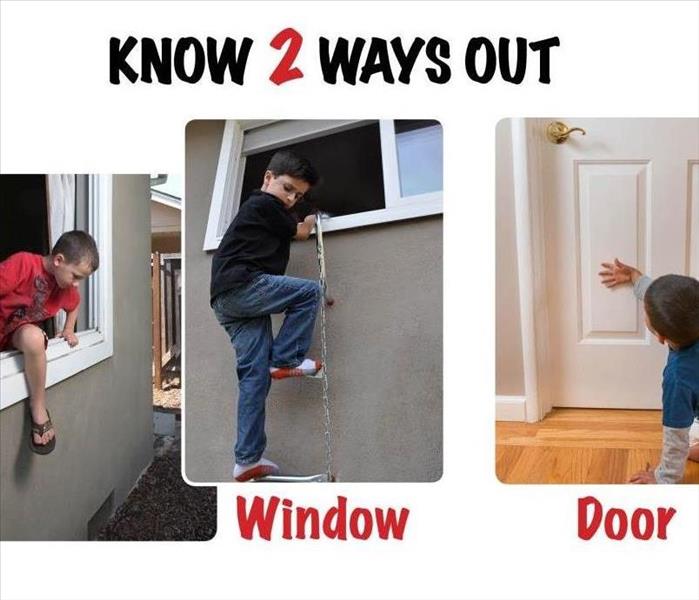 Know 2 Ways
Know 2 Ways
How Long Do You Have to Escape a House Fire?
How long do you have to escape a house fire? It's way less time than you think.
Everyone knows not to dawdle if their house is on fire, but you may believe you have some time to make a safe exit. Well, think again.
Gail McGovern, the president of the Red Cross reveals that you only have two (just two!) minutes to get out of your home before you might get stuck in the flames. This is because it only takes about five minutes for a fire to consume your entire house. And with one in seven people dying in a house fire each day, there's little room for error.
Practicing fire safety certainly requires vigilance, but it doesn't take too much effort to avoid a tragedy. First, make sure you have smoke alarms in your home (5 million American homes don't). You need one in every bedroom, one outside every sleeping area, and at least one on every floor. Make sure the detectors are working and refresh their batteries when you change the clocks for the beginning and end of Daylight Saving Time.
Also, it's important to practice fire drills with your family. You should go over possible routes to get out of your house fast, and consider getting escape ladders for any rooms on upper floors. Choose a meeting place outside that's a safe distance from your home.
And of course, you should take steps to prevent fires from happening in the first place. Watch the video to learn which common mistakes you might be making.
When fire and water damage strikes, a fast response is critical. We’re dedicated to responding immediately, day or night, to your Southern McHenry County home or business. A faster response helps to prevent secondary damage and to reduce cost.
We are available to assist you 24/7/365.
Source: http://www.goodhousekeeping.com/ http://www.redcross.org/
Six Common Causes of Fires In Your Home
1/4/2019 (Permalink)
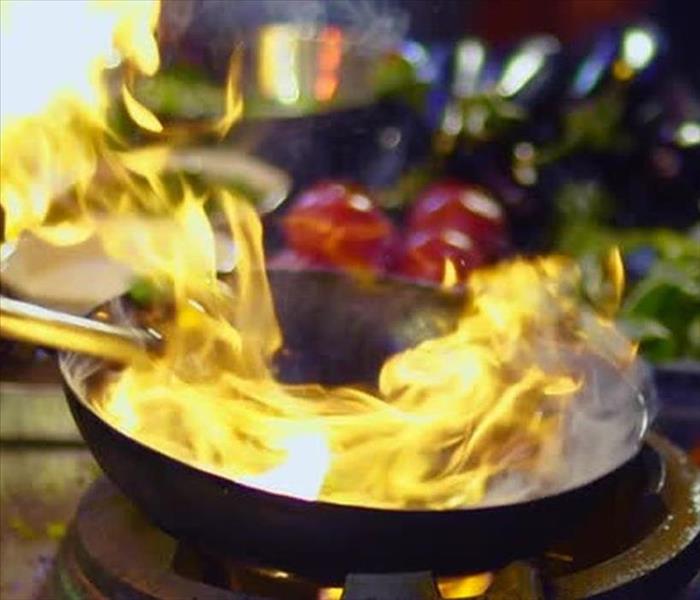 Grease Fire
Grease Fire
Six Common Causes of Fires In Your Home
These below causes are preventable if caution is practiced.
Electrical
Electrical fires are another common type of home fires. One of the leading culprits is the over-use of extension cords. Extension cords are designed to safely pull a certain amount of amps, so make sure to read labels and know the limitations of the cord you are using. We recommend having an electrical inspection performed by a certified electrician at least once a year.
Cooking Incidents
The leading cause of residential fires are incidents related to cooking. Cooking incidents actually make up about 42% of reported house fires in the country! For example, an oven or stove left on and unattended is a disaster waiting to strike.
Unsupervised Children
Teaching children about fire safety is definitely something every parent should consider. It is extremely common for items such as lighter and matches to be left within reach of children who are not aware of the dangers of fire.
Smoking
Smoking is the source of many house fires and leads to almost 1,000 deaths a year. Lit cigarettes that have been left unattended, forgotten about can make contact with flammable items in your home and lead to a fire. Another common occurrence is smokers falling asleep while smoking in their home. We recommend not smoking in your home or quitting altogether, however, if you choose to smoke in your home you should always make sure to extinguish your cigarette.
Candles
Candles should never be left unattended but oftentimes are. When leaving a room with a burning candle make sure to blow it out or take it along with you if necessary. Forgotten candles are very dangerous and can quickly lead to a fire disaster.
Dryers
Dryers are all too often forgotten! It is important to remember to empty out your dryer vents and be certain that they are properly vented. Remember to maintain your dryer by cleaning the vents at least once a year.
When Fire Disaster Strikes
There are many possible causes and contributors to residential fires. Being aware of the causes listed above will go a long way in helping to prevent fire damage or much worse in your home. In case of an emergency, please be sure to dial 911 to reach a local emergency responder. Also, keep in mind that SERVPRO of Southern McHenry County performs excellent fire restoration services and is available 24/7 to respond to your needs.
Source: NFPA (National Fire Protection Association
Five Ways to Prevent Electrical Fires
11/14/2018 (Permalink)
 Faulty Toaster On Fire
Faulty Toaster On Fire
Electrical fires can get out of control quickly. Prevent them from ever occurring with these tips.
Over 14670 people sustain injuries or 3400 deaths due to electrical fires during 2017 in the United States. And almost every one of those injuries or deaths could have been prevented. The fact is that many fires of this nature happen because of human error. Taking preventative steps now will help you avoid a fire in the future. Here are 5 ways you can prevent such a fire in your McHenry County home or business.
Replace or fix broken plugs and cords
Frayed or nicked electrical cords or broken pugs can overheat or cause sparks. Both of these can cause a fire. It is not difficult to replace most appliance cords or plugs. If you are not able to do the work yourself, an electrician can do the work for you.
Don't overburden electrical outlets
Plugging too many appliances or electronics into the same outlet can cause overheating. An overheated plug can spark or short out completely and cause a fire. If you need to plug more than one thing into an outlet, use a power strip with built-in overload protection.
Have faulty wiring fixed
If you have flashing blinky lights, buzzing outlets, breakers that constantly trip or funny smells, you may have faulty wiring somewhere. Older homes often contain aluminum wire or even white ceramic "knobs" and black "tubes" that encase the copper wiring, which are both prone to cause fires more than modern copper wiring. It may be time to rewire your century-old building. Faulty wiring is often hidden in the walls or ceiling cavities. So, leave faulty wiring to an electrician. He can diagnose and fix the problem quickly and effectively.
Keep flammable materials away from electrical appliances
Your home and business abound with flammable materials, such as towels, rugs, draperies, paper and blankets. Keep electrical appliances well away from these flammable materials. This includes electric space heaters, hair irons, hair dryers, and lamps. Never hide cords under rugs because they cause fires by overheating.
Get an electrical inspection done
If your home or business is an older building, consider a thorough inspection performed by a professional electrician. Older homes often contain aluminum wire or even white ceramic "knobs" and black "tubes" that encase the copper wiring, which are both prone to cause fires more than modern copper wiring. It may be time to rewire your century-old building.
Get Rid of Faulty or Defective Appliances
You should stop using an electrical appliance that is sparking, tripping a breaker, or overheating. Things like these are time bombs waiting to happen, and just because nothing has gone wrong yet doesn’t mean nothing will. There is a reason they are called accidents!
Each of these tips will help you prevent an electrical fire from starting in your home or business. So, if the worst happens, and you do have damage from a fire, you need the help of professionals to get your home and business straightened out. Call SERVPRO of Southern McHenry County at 847-516-1600.
Source: HOWSTUFFWORKS
www.usfa.fema.gov/data/statistics/
The Aftermath of a Home Fire
9/1/2018 (Permalink)
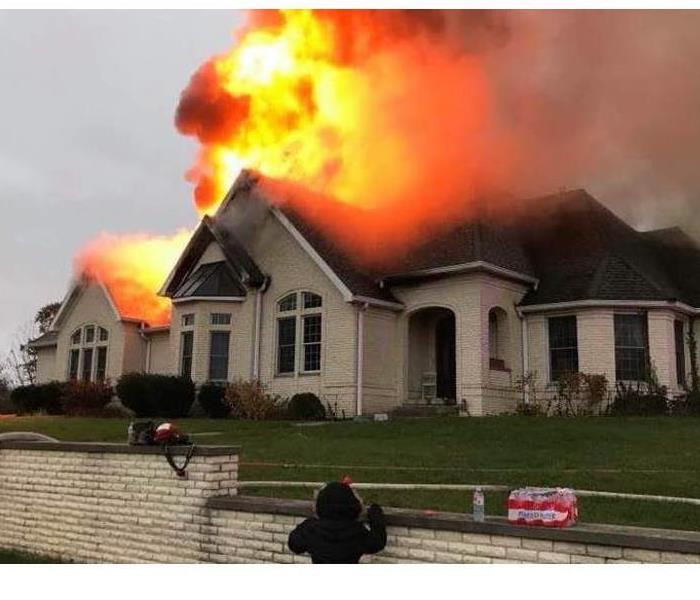 House fire in Cary
House fire in Cary
The Aftermath of a Home Fire
Recovering from a fire is not easy by any means. It is an emotionally draining process that turns your life upset down. The hardest part comes at the beginning, when you feel helpless and are completely unsure as to how to proceed. With that in mind, our goal is to present to you the fundamental steps you need to take immediately after the fire is extinguished.
Deal With Insurance
You should already be on the phone with your insurance agent before the firefighters even get done putting out the fire. Mind you, this is just the beginning. After a few days, you’ll need to get a copy of the official “fire report” from your local fire department. The insurance agency will likely send an adjustor out to survey the damage and help you get in touch with a restoration agency, such as the professionals at SERVPRO.
If you are renting, then you’ll obviously need to contact the owner of the home. If you own home but don’t have insurance, on the other hand, then you’ll want to speak with the Internal Revenue Service. You might be eligible for something known as casualty loss.
Settle in Somewhere
Most likely, your home is currently in an unlivable state, meaning you’re going to have to find somewhere else to stay. Your best bet is to stay with friends or family. However, if that’s not an option, check with your insurance company to see if your policy covers temporary living expenses. Otherwise, contact the American Red Cross.
Before you leave, try to rummage through your home for some essential items like the following: Identification Cards, Medications, Eye Glasses / Hearing Aids, Wallets, Credit Cards / Checkbooks, Money. **Only do this AFTER you get permission from the firefighters to reenter your home.**
Turn Off Utilities
Make certain you get all of your primary utilities turned off. Why waste money for services when you are not even living in your home? Plus, restoration cannot be performed on your home if there’s still electricity and such running through it. The risks of electrocution would be far too high.
Contact a Restoration Company
This is perhaps the most important step. You’ll need to contact a professional, full-service restoration company, such as SERVPRO. Our company is trained specifically to deal with post-tragedy damage. Below is a list of some of the things you can expect us to do:
- The company will start by removing all the water from your home. During a fire, a lot of water from the firefighters hoses usually collects all over the place. Plus, fires sometimes cause pipes to burst, thus leading to even more severe flooding. The point is that restoration cannot begin until the water is first removed.
- The company will then start with water restoration. Carpets, walls, ducts must be dried. Mold must be removed. Just this step itself can take a few days.
- Next is the actual fire restoration. First and foremost, the company will inspect the structural foundation of your home and fix any major problems. Obviously, if a ceiling is about to crash, then it must be attended to before any other restoration efforts can be completed.
- Once the structural foundation is secure, the specialists will start cleaning up soot/smoke damage, deodorizing everything (carpets, walls, furniture, etc.) and basically returning the home back to normal. If anything is so damaged that it cannot be repaired, it’ll be removed and thrown away. It’s your responsibility to let your insurance company know what items you lost.
- Last, but not least, the company will clean up the remaining mess (dust, debris, etc.) and rearrange everything back into place.
Move Back In
Finally, you get to move back into your home and resume life. Unfortunately, it can take quite a bit of time before you even get to this final step. We’re talking about several weeks. The truth is that restoring a home from a fire takes a lot of time, a lot of resources and a lot of money.
Just remember to keep in close contact with your insurance company through the whole process. If all goes well, you’ll get your home back in one piece, and you’ll get your lost possessions replaced.
When you have fire, water and mold restoration service needs, give the experienced professionals at SERVPRO a call at 847-516-1600.
Chimney Cleaning Tips
7/8/2018 (Permalink)
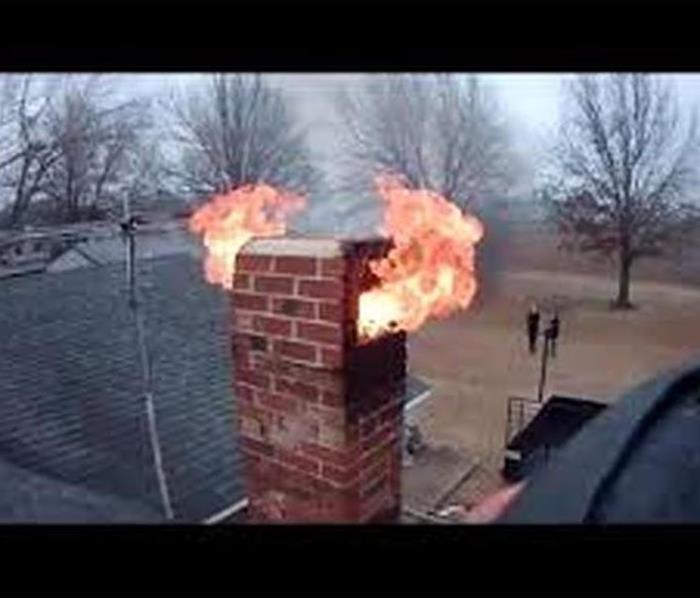 Keep your chimney clean to prevent fire damage in your home!
Keep your chimney clean to prevent fire damage in your home!
Chimney Cleaning Tips
At SERVPRO of Southern McHenry County, we know the lovely warm glow a chimney can add to any home. Sitting in front of a fireplace in your Nashville home on a crisp day is a wonderful way to relax and enjoy an evening with family. There is nothing more important than keeping your home and family safe. To help keep those fires going, it's useful to make sure the chimney is periodically cleaned. Chimney cleaning can help a fireplace stay in good shape and reduce the risk of a fire breaking out in your home. Additionally, the chimney allows smoke, fumes and dangerous toxins escape the home through its ventilation. Read on for some helpful tips on having your chimney services.
Inspect the Brick
All chimneys should be completely cleaned at least once a year. Proper cleaning is important to make sure that the chimney is in good working order. Any homeowner should also perform an inspection on their own. This can help identify any potential problems that must be addressed as soon as possible. It's a good idea to bring a flashlight and have a good look at the floor. All the ashes in the chimney accumulate here. The flooring needs to be kept in good shape to make sure the fire can be turned on. Note any problems with the brick surrounding it. The bricks used in a fireplace are more heat tolerant than ordinary bricks. They need to be maintained to prevent any fire in the fireplace from spreading to other areas of the home. If a single brick is out of place, this can make the rest of the chimney far less functional.
Have a Look Up
After having a good look at the area surrounding the fireplace, it's a good idea to have a look at the rest of the chimney. Put on some old clothes and get in the area surrounding the fireplace. Have a look at the chimney area. You should see if there's any obstruction or other issues. Small birds and rodents often find themselves stuck or you could have a thick layer of creosote and soot sticking to the flue and masonry inside the chimney. When this gets too thick, all it takes is a spark and you have a chimney fire on your hands.
According to the National Fire Prevention Association, 30 percent of home fires are caused by chimney fires. Be sure your home is not one of them and have your chimney cleaned regularly. If you do run into trouble with smoke or fire in your home give us a call at 847-516-1600. At SERVPRO of Southern McHenry County, we take pride in making it like it never happened
Contents Restoration for your Southern McHenry County Home
5/1/2018 (Permalink)
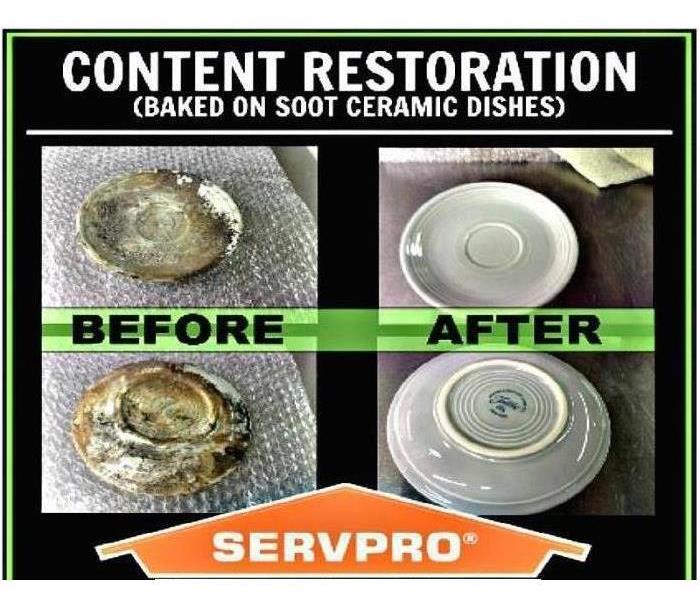 Content Before and After
Content Before and After
CONTENTS RESTORATION
From furniture to antiques to artwork and appliances, we'll treat your treasures with the care they deserve. While some items can be cleaned on-site, in many cases we'll need to inventory, pack out and transport the contents of your property to our state-of-the-art facility to ensure the best care possible.
Key Issues
- Contents may need to be cleaned off-site
- Contents inventory
- Determine replacement and restoration
- Pack
- Ozone treatment
- Cleaning
- Odor removal
- Secure
- Return
Contents Inventory
- We arrive on-site and inventory all of your personal belongings.
- We carefully pack all salvable items to transport to our secure warehouse and cleaning facility.
- Unsalvageable contents are inventoried and discarded.
Contents Valuation
We have trained professionals to help you establish replacement values versus restoration costs. We are also available for pricing of non-salvable inventory items.
Restoration
- Thorough cleaning
- Proper handling of all electronics
- Photographs and artwork
- Fabrics
- Clothes
- Memorabilia
- Antiques
- Soft goods
If you need the above services contact SERVPRO of Southern McHenry County at 847-516-1600.
Four Fire Damage Restoration Factors for your Southern McHenry County Homes
3/11/2018 (Permalink)
 Never Leave a Flame Unattended Says SERVPRO
Never Leave a Flame Unattended Says SERVPRO
SERVPRO Steps to Restore Your Southern McHenry County Fire Damaged Home
A serious situation is a given with heavy Southern McHenry County fire damage. If you try to complete the remediation process on your own, you will often expose yourself to health and safety hazards that may lead to injury. For these reasons and more, calling a professional fire damage restoration team like SERVPRO is the most prudent course of action when disaster strikes your residential property. Learn more about how remediation experts can assist you with the property restoration process by reviewing this short outline: Fire Damage Remediation Techniques. There are many factors and services involved to restore your property following a fire. Some are drying the property, cleaning the HVAC system, rebuilding the damaged structures of the property, and removing unsalvageable goods. Drying Your Home. Drying your property following a fire is important. Typically, firefighters perform extinguishing work that leaves excessive water in your living space. This standing and hidden water create the perfect breeding ground for mold if left unattended. To prevent a mold infestation--starts with 48-72 hours after water intrusion--SERVPRO will extract volumes of water using powerful pumps, and water extractors. Now additional drying and moisture removal can begin using specialized equipment like air-moving machines and dehumidifiers. HVAC System. Residual particulates from a house fire coat the coils and filters of HVAC systems with debris and soot. Soot is not smoke, but an oily by-product of partially combusted materials like plastics and vinyl. The ductwork must also be cleaned and deodorized. Special techniques, along with IICRC and corporate training enable our technicians to complete successfully this wipe down and clean up stage. If this process is done properly, staining, painting, and replacement of drywall and ceilings are minimized, along with your costs. Structural Repair. When fire damage has compromised structural materials such as trusses, floor joists, drywall, and the electrical or plumbing systems, then the affected areas may have to be replaced. When feasible, repair is done before replacement. Our fire damage restoration experts can complete this work, or we can work and instruct your building contractors on your behalf. Removing Unsalvageable Materials. SERVPRO utilizes an industry developed technology called XactContents that inventories all household content. Categorizing of these items is then made as salvageable, non-salvageable, or questionable. The XactContents benefits you regarding the claims process with your insurance adjuster. We will help and cooperate with your okay. Fire damaged items beyond repair must be disposed of properly. If not, these items could contaminate other areas of the property.
Don't Delay-Get Great Fire Damage Remediation Services Today! In many cases, Southern McHenry County property fires send homeowners into a panic. Don't let this happen to you. Instead, recognize that hiring a top-notch fire damage restoration company is the key to restoring your property to preloss condition while maintaining your emotional equilibrium. SERVPRO works for you to keep costs down, treat you with empathy, and get you back home ASAP.
Our Fire Damage Restoration Services
SERVPRO of Southern McHenry County is locally owned and operated, so we are part of this Charlotte community too. When you have a smoke, soot or fire damage emergency, we’re already nearby and ready to help. We take pride in being a part of the Cary, Algonquin, Crystal Lake, Lake in the Hills, Huntley, Marengo, Union, Fox River Grove and Woodstock communities and want to do our part in making it the best it can be. Call us for immediate assistance. (847) 516-1600
Smoke Detector Safety
2/1/2018 (Permalink)
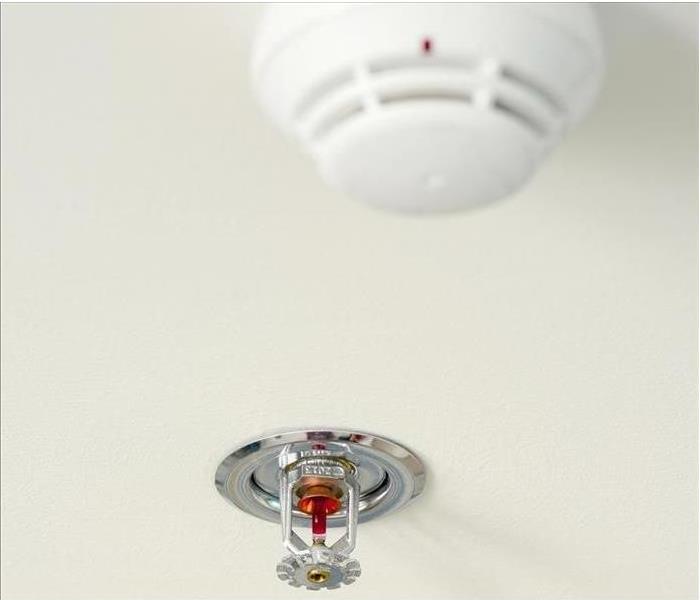 Smoke Detector and Sprinkler
Smoke Detector and Sprinkler
Smoke Detectors Smoke detectors are devices that are mounted on the wall or ceiling and automatically sound a warning when they sense smoke or other products of combustion. When people are warned early enough about a fire, they can escape before it spreads. Prices start at about five dollars. Every year thousands of people die from fires in the home. Fire kills an estimated 4,000 Americans every year. Another 30,000 people are seriously injured by fire each year. Property damage from fire costs us at least $11.2 billion yearly. Most fire victims feel that fire would "never happen to them." Although we like to feel safe at home, about two-thirds of our nation's fire deaths happen in the victim's own home. The home is where we are at the greatest risk and where we must take the most precautions. Most deaths occur from inhaling smoke or poisonous gases, not from the flames. Most fatal fires occur in residential buildings between 11 p.m. and 6 a.m. when occupants are more likely to be asleep. More than 90 percent of fire deaths in buildings occur in residential dwellings. A Johns Hopkins University study, funded by the United States Fire Administration, found that 75 percent of residential fire deaths and 84 percent of residential fire injuries could have been prevented by smoke detectors. There are Two Basic Types of Smoke Detectors 1. Ionization detectors - Ionization detectors contain radioactive material that ionizes the air, making an electrical path. When smoke enters, the smoke molecules attach themselves to the ions. The change in electric current flow triggers the alarm. The radioactive material is called americium. It's a radioactive metallic element produced by bombardment of plutonium with high-energy neutrons. The amount is very small and not harmful. An ionization detector responds satisfactorily to all types of fires, however it generally responds quicker to flaming fires. 2. Photoelectric detectors - These type of detectors contain a light source (usually a bulb) and a photocell, which is activated by light. Light from the bulb reflects off the smoke particles and is directed towards the photocell. The photocell then is activated to trigger the alarm. A photoelectric detector generally responds more quickly to smoldering fires. Choosing a Smoke Detector When choosing a smoke detector, there are several things to consider. Think about which areas of the house you want to protect, where fire would be most dangerous, how many you will need, etc. East Side Fire Department recommends that every home have a smoke detector outside each sleeping area (inside as well if members of the household sleep with the door closed) and on every level of the home, including the basement. On floors without bedrooms, detectors should be installed in or near living areas, such as dens, living rooms or family rooms. The safest bet is to have both types of detectors or a combination detector with a battery back up. Be sure to check for a testing laboratory label on the detector. It means that samples of that particular model have been tested under operating conditions. Check to see if it is easy to maintain and clean. Installation The placement of smoke detectors is very important. Sleeping areas need the most protection. One detector in a short hallway outside the bedroom area is usually adequate. Hallways longer than 30 feet should have one at each end. For maximum protection, install a detector in each bedroom. Be sure to keep the detector away from fireplaces and wood stoves to avoid false alarms. Place smoke detectors at the top of each stairwell and at the end of each long hallway. Smoke rises easily through stairwells. If you should put a smoke detector in your kitchen, be sure to keep it away from cooking fumes or smoking areas. Proper mounting of a smoke detector is also important. You can mount many detectors by yourself, but those connected directly to your household wiring should have their own separate circuit and be installed by a professional electrician. If you mount your detector on the ceiling be sure to keep it at least 18 inches away from dead air space near walls and corners. If you mount it on the wall, place it 6 to 12 inches below the ceiling and away from corners. Keep them high because smoke rises. Never place them any closer than three feet from an air register that might re-circulate smoke. Don't place them near doorways or windows where drafts could impair the detector operation. Don't place them on an uninsulated exterior wall or ceiling. Temperature extremes can affect the batteries. Maintenance Keeping smoke detectors in good condition is easy. Always follow the manufacturer's instructions. Be sure to replace the batteries at least once every year or as needed. East Side Fire Department recommends changing the batteries in your smoke detectors twice annually. Most models will make a chirping, popping or beeping sound when the battery is losing its charge. When this sound is heard, install a fresh battery, preferably an alkaline type. Keep extra batteries on hand. Check the smoke detector every 30 days by releasing smoke or pushing the test button. Clean the detector face and grillwork often to remove dust and grease. Never paint a smoke detector, as it will hamper its function. Check your detector if you've been away from home for an extended period of time. If you're looking for a unique gift for somebody, consider giving him or her a smoke detector. It's an interesting gift that can save lives and it shows that you care.
8 Safety Tips You Should Keep In Mind During This Thanksgiving Day!
11/5/2017 (Permalink)
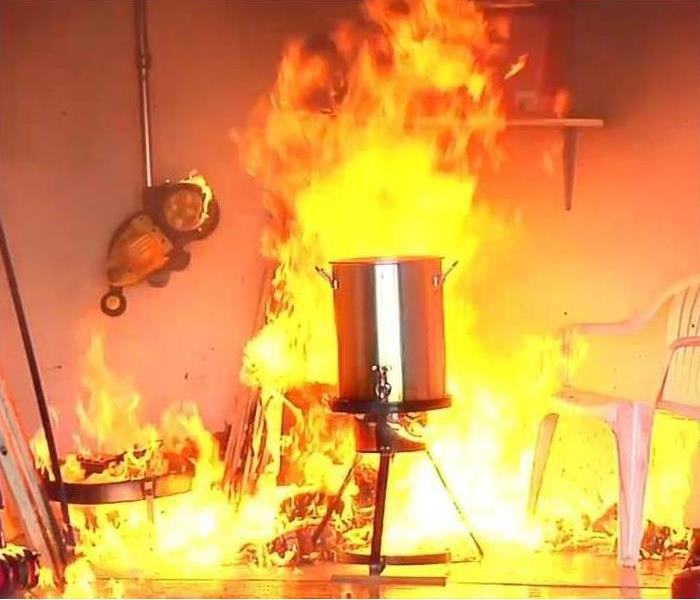 This what could happen while deep frying a turkey.
This what could happen while deep frying a turkey.
According to the United States Fire Administration, there are the average number of reported residential building fires on Thanksgiving Day was more than double (2.1 times more) the average number of fires in residential buildings on all days other than Thanksgiving. The average losses for Thanksgiving Day fires in residential buildings, however, were less than the same measures for non-Thanksgiving Day fires in residential buildings. The majority of Thanksgiving Day fires in residential buildings took place in one- and two-family dwellings (65 percent) followed by multifamily dwellings (29 percent).
- In case of any emergency, call 911!
- Never wear loose fitting clothing when cooking. Those can easily could ignite and catch fire.
- Don't leave your food unattended on the range or in the oven.
- Keep children out of the kitchen when cooking.
- Remove anything near the stove that could catch fire, including wooden utensils, oven mitts, plastic bags, or towels.
- Take extra precaution with turkey fryers. Turkey fryers increase your risk of burn or fire hazards. Be sure the oil used to fry the turkey is the right temperature and always fry outside in a well-ventilated area. Never put water on a grease fire use a fire extinguisher or flour to put it out.
- Keep a fire extinguisher in the kitchen. Be familiar with how the extinguisher works and teach your family to use it as well. Keep a fire extinguisher in the kitchen and teach your family how to use it.
- Stay alert. If you are sleepy or have consumed alcohol, don’t use the stove or stovetop.
Sources:
- “Thanksgiving Safety Tips”
http://abcnews.go.com/blogs/lifestyle/2014/11/5-fire-safety-tips-to-keep-in-mind-this-thanksgiving/
Fire Damage Repair Should Be Done By Professionals
10/8/2017 (Permalink)
With quick and decisive fire damage repair, even the worst disasters can be put in the past. Roaring flames have been one of man’s greatest enemies since the dawn of ancient times, and though it’s easier to handle these days, it can still cause havoc if it gets out of control. Not only can the flames cause enormous damage, the ash, soot and smoke residue that remains will make the home almost noxious to live in. Both can create irritating odors, discolor walls or ceilings and cause breathing issues if there is a high concentration of ash left over.
Professional fire damage repair will remove the ash, odor and smoke residue left behind. This has to be done quickly because ash is acidic and will cause materials to deteriorate if allowed to sit for long. SERVPRO of Southern McHenry County technicians will work hard to provide a thorough cleanup. This will include treatment of every surface that is affected by ash and soot. This includes cleaning down walls, ceilings, furniture and countertops. Ash and smoke will almost always be present in the vents and ducts as well, as they are quickly taken up by the HVAC system. SERVPRO’s technicians will access the home’s ducts to clean them out as well, preventing either from entering the home once again.
Upon eliminating all of the ash, soot, and smoke, the home will quickly be free of any lingering odor. It will be “Like it never even happened.”
Have Questions about Fire, Smoke, or Soot Damage? Call Us Today – (847) 516-1600
We service all of these communities in Southern McHenry County Algonquin, Cary, Crystal Lake, Fox River Grove, Huntley, Lake in the Hills, Trout Valley, Marengo, Village of Lakewood, Village of Oakwood Hills, Woodstock and Union.
Fire Prevention Week
10/1/2017 (Permalink)
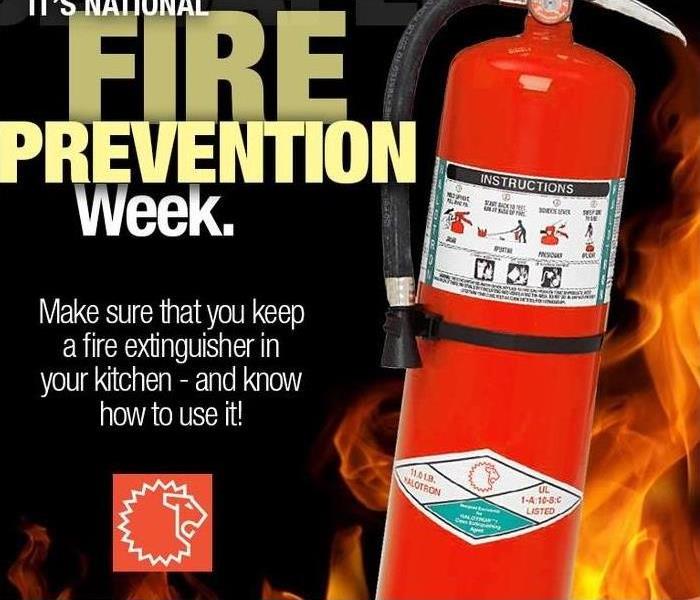 Celebration of Fire Prevention Week
Celebration of Fire Prevention Week
This year, Fire Prevention Week in the United States is from October 8th through October 14th. According to the National Archives and Records Administration's Library Information Center, fire prevention week is on Record as the longest running public health observance.
The first National fire prevention week was October 4th through the 10th in 1925. This started a tradition of the President of the United States signing a proclamation of recognition for the annual occasion. The yearly event falls on the week of October 9th and runs Sunday through Saturday.
The week is in commemoration with the "Great Chicago Fire". The Great Chicago Fire took place on October 8th-9th 1871. This dreadful fire burned over 2,000 acres, destroyed over 17,400 structures, left 100,000 people homeless, and killed more than 250 people. Legend has it, the fire started after a cow kicked over a lamp.
Source: www.nfpa.org
Halloween Fire Safety
10/1/2017 (Permalink)
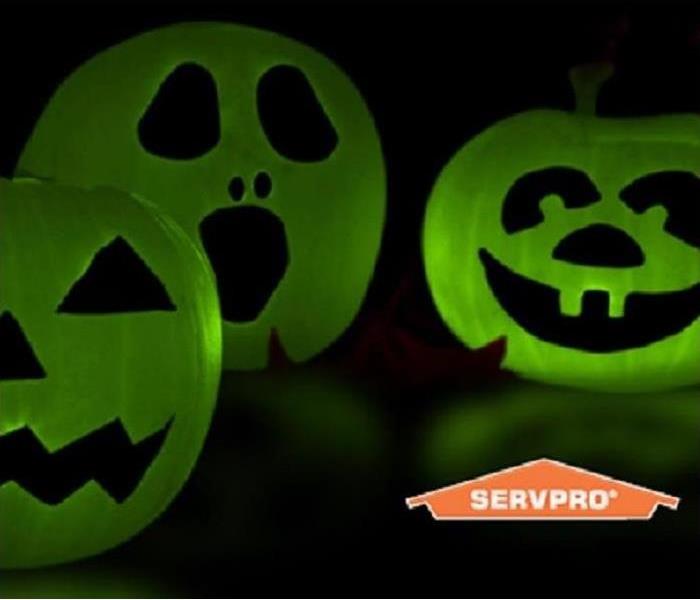 Have a Safe & Happy Halloween from SERVPRO of Southern McHenry County
Have a Safe & Happy Halloween from SERVPRO of Southern McHenry County
For each year from 2011 to 2013, an estimated 10,300 fires were reported to fire departments in the United States over a three-day period around Halloween and caused an estimated 25 deaths, 125 injuries and $83 million in property loss. According to the National Fire Protection Association (NFPA) nearly half of decoration fires in homes occurred because the decorations were too close to a heat source.
Don't let these statistics scare you away from celebrating Halloween to the fullest! The vast majority of these fires are easily preventable. Here are a few safety tips to help ensure the holiday remains festive and fun.
- Keep decorations far away from open flames and other heat sources like lights and heaters. Remember to keep all of your home's exits clear of decorations so nothing blocks escape routes.
- Try a battery-operated candle or glow stick in jack-o'-lanterns. If you want to use real candles, be extremely careful. In this case, use long, fireplace-style matches or a utility lighter when lighting them inside jack-o'-lanterns. If there are children around, make sure they are watched at all times when candles are lit. Place the lit pumpkins well away from anything that can burn and far away from driveways, doorsteps, walkways and yards -- anyplace where trick-or-treaters may walk.
- Use flashlights as alternatives to candles or torch lights when decorating walkways and yards. They are much safer for trick-or-treaters whose costumes may brush up against the lighting as they walk to from your door.
- Choose costumes that don't require long-trailing fabric. If your child is wearing a mask, make sure the eye holes are large enough so they can clearly see where he is walking to prevent trips or falls near dangerous or flammable items.
- Talk to your children and remind them to stay away from open flames, including jack-o'-lanterns with candles inside. Provide them with flashlights or glow sticks to carry for lighting as part of their costume.
Source: National Fire Protection Association (NFPA)
Smoke Odors and Fire Damage Often Act in Tandem
8/23/2017 (Permalink)
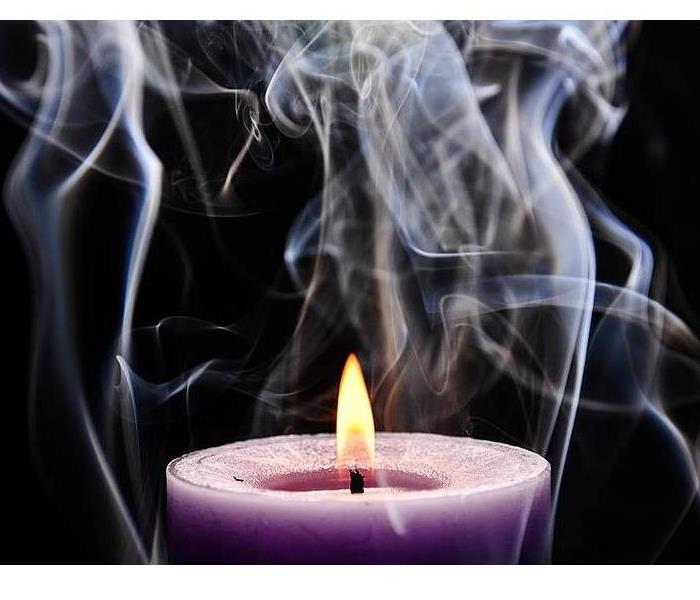 Rely on SERVPRO to Restore Your Fire and Smoke Damaged Property in Southern McHenry County
Rely on SERVPRO to Restore Your Fire and Smoke Damaged Property in Southern McHenry County
SERVPRO's Many Proven Techniques Mitigate Smoke Odors and Fire Damage
Following a fire, early deodorization is essential as a follow-up to cleaning and odor removal procedures. Deodorization gives a clear indication of how effective an odor removal process is working. Deodorizing usually requires multiple techniques to produce the proper results. As a multi-step process, this helps to reduce cross-contamination of smoke residue. Odor removal should begin in the area where the fire originated.
Fire odors are caused by different sources such as soot, flames, contaminated materials that become damaged, all of which require different methods of deodorization. For a fire damage event in Southern McHenry County, your home or business may need a water-based deodorant treatment. The purpose of this method is to counteract gas smells at the floor level and to keep them from becoming airborne. A compression sprayer is used, which is filled with a water-based deodorant and is then applied to the floor along with a safe odor counteractive chemical for the smoke. Another deodorant process involves a time-release granulated deodorant that is applied to the floor. These specialized granulates release odor counteractants to reduce the intensity of smoke odors. Granule treatment should only be performed by SERVPRO because of the particular care that should be taken on different floor surfaces. The last emergency deodorization procedure used is an odor counteractive spray or fog. This method is called “thermal fogging,” to recreate the conditions that exist during a fire. Tiny particles become deeply embedded into surfaces, just like smoke particles during a fire. Odor counteractant vapors will continue to work throughout the SERVPRO restoration project. Of the varied deodorizing techniques, the first step of any odor removal treatment is to remove the source of the odor. The second basic step is to clean the area of residue. Removing odor sources and cleaning residues is perfunctory in every deodorization methods. During a fire, odors can come from some sources, both indoors and outdoors. Of course, HVAC systems must not be activated during these procedures, and quite often a thorough and comprehensive duct cleaning are needed. SERVPRO of Southern McHenry County technicians are trained to identify and eliminate offensive odors. We have the training, tool and industry approved equipment to deodorize and remove offensive odors from a fire, water damage or mold. Acting fast can save your property even after fire damage. We are available 24 hours a day, give us a call – (847) 516-1600 and let us help restore your property to a preloss condition.
Enjoy Your Summer Fires by Building a Safe Fire Pit
8/11/2017 (Permalink)
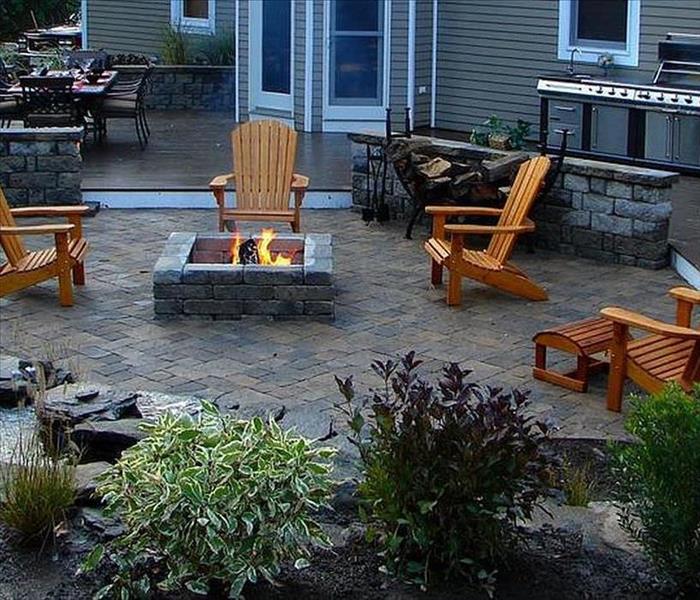 Be Safe By The Pit
Be Safe By The Pit
It's finally that time for outdoor BBQs, parties, and camp-outs and it's important to always keep safety at the forefront. Whatever type of pit you have in mind, make sure you follow all the rules for proper ignition. This will keep not only your family and friends safe but also those around you, like your neighbors.
Getting Started
Before you start digging to build your summer fire pit, think through the process. Where are you going to build your pit? How deep should you dig? What should you use to create the above ground wall? When selecting your spot, take care not to dig too near other items that would easily flame up. So place your pit at least ten feet from other structures and avoid overhanging branches. It's important that if you are installing a prefabricated pit, you need to ensure your ground is level. Using pavers is a great way to ensure that any burning embers that may escape won't spread to other structures or brush.
When digging your own summer pit, ensure you remove at least one foot of earth. Place large stones or landscaping bricks around the outside edge of your site and cover up at least one foot. Using concrete to secure your bricks will provide a safer, stronger pit. Once you have your pit completed, create a ten-foot circumference around it by clearing any brush, leaving only bare earth, or by using pavers to secure the area and help prevent drifting embers.
Enjoying Your Pit
Light your pit before the light is too dim. Twilight is a bit late, but with some skill, you should be able to get it lit. Make sure you have enough water stored near your pit to quickly douse flames. Finally, keep your wood well away from the pit. And it goes without saying; no horseplay should ever happen near the pit. While we would rather you enjoy your summer safely; the professionals at Southern McHenry County can help you with any fire disaster--large or small.
Preventing Puffbacks
8/6/2017 (Permalink)
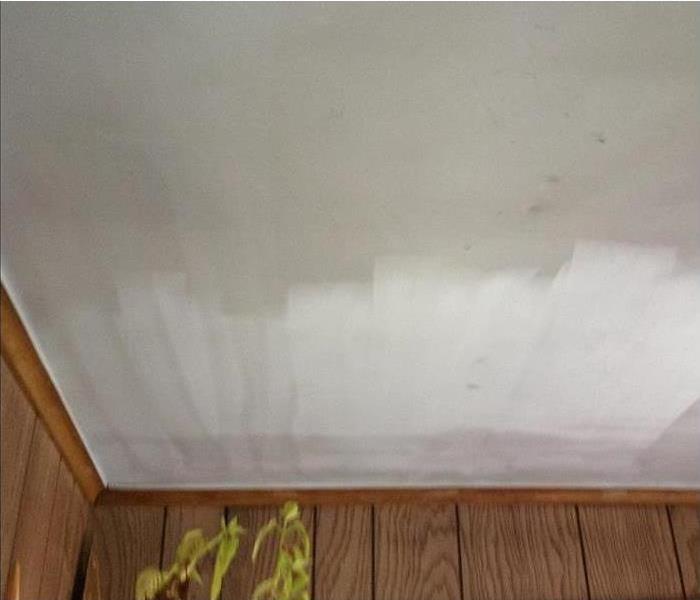 During the Cleaning process after a puff back
During the Cleaning process after a puff back
A puffback is a messy furnace malfunction that occurs when an oil burner backfires, sending soot throughout the interior of a home. It can happen all at once, covering the interior in grimy soot, or it can leak soot more gradually.
Initially, many people mistake soot for dust and simply wipe it away. However, once cleaned, this “dust” often reappears and can sometimes be accompanied by a strong, oily odor. There are several steps your clients can take to prevent damage to their home. Remind them to:
- Have the oil-burning furnace professionally checked and cleaned annually.
- If you have a fireplace make sure is maintain properly.
- Keep an eye out for traces of soot around their home.
- Install a carbon monoxide monitor. Puffbacks (and the soot they create) will increase the carbon monoxide levels in their home. A carbon monoxide monitor can help to detect the puffback in its early stages.
If soot begins accumulating on objects or walls within their home, they should turn off the heating system immediately. Contact a heating professional to service the heater and restore it to proper working order.
Fortunately, if your client does experience a puffback, SERVPRO has the knowledge and experience to complete a thorough cleaning and removal of any soot and odors. Our Fire Restoration Team will respond immediately and make it look Like it never even happened®
Call SERVPRO of Southern McHenry County at 847-516-1600.
Fire and Smoke Damage Clean up tips From SERVPRO of Southern McHenry County
7/28/2017 (Permalink)
 Kitchen fire and smoke damage
Kitchen fire and smoke damage
Damage can come in all forms including fire and smoke damage, and water damage. If you don’t act immediately, you can be faced with additional expenses to fix that damage. We have compiled a list of tips you can enact when facing such damage. Today we are going to focus fire and smoke damage.
- Call a professional. Some by-products can cause etching which is irreversible fairly quickly.
- Do not touch anything that has been damaged with your bare hands. Your hands carry oil which can cause additional damage.
- Open up the house and air out any smoke damage, if the outside temperature is warm.
- Do not wash any of the walls that have smoke/fire damage. The wrong cleaning component can cause more damage.
- Clean off your Formica, chrome, porcelain or aluminum fixtures to prevent permanent tarnishing.
- Call a professional to clean up any upholstered furniture and carpets. Don’t clean them yourself.
- Keep away from anything and everything electronic until they have been checked out by and cleared by a professional.
- Replace your air filter on your furnace if you use forced air.
- If your ceiling is wet, do not use any of the fixtures.
- Throw away all food packages that have been opened.
- Any clothing that has been tarnished, send to a professional for cleaning.
- Clean out the refrigerator/freezers and keep the doors open, if the electricity is off.
If you have any questions or you need emergency call us at 847-516-1600.
Candle Fire Tips and Facts
7/18/2017 (Permalink)
 A candle fire in progress.
A candle fire in progress.
The winter holiday season is upon it is traditionally a festive time of year filled with colorful decorations and family gatherings, it is too often a time of tragedy and loss as well. National Fire Protection Association (NFPA) statistics indicate that 28% of all home fires and 35% of home fire deaths occurred between the months of December, January, and February. These winter fires result from a variety of sources. From 2009-2013, U.S. fire departments responded to an estimated 9,300 home structure fires that were started by candles. These fires caused 86 deaths, 827 injuries and $374 million in direct property damage. And the top three days for home candle fires were Christmas, New Year's Day, and Christmas Eve.
Facts and figures
During the Six-year period of 2009-2014
- Candles caused 3% of reported home fires, 3% of home fire deaths, 6% of home fire injuries, and 5% of the direct property damage in home fires.
- Candle fires occurred in these rooms: 44 percent of candle-sparked fires start in bedrooms, , 19 percent in living rooms, family rooms or dens, 11 percent in bathrooms, seven percent in kitchens, and four percent in dining rooms.
- Roughly one-third (36%) of home candle fires started in bedrooms. These fires caused 32% of the associated deaths and 47% of the associated injuries.
- Falling asleep was a factor in 11% percent of the home candle fires and 30% of the associated deaths.
- On average, 25 home candle fires were reported per day.
- More than half (58%) of home candle fires occurred when some form of combustible material was left or came too close to the candle.
- December is the peak time of year for home candle fires. In December, 11% of home candle fires began with decorations compared to 4% the rest of the year.
Here are some candle safety recommendations:
- Don't leave them unattended. If leave a room, extinguish the candle and re-light it when you return.
- Maintain a two-foot circle of safety around a lighted candle. It shouldn't be near clothing, books, curtains, etc. A breeze from an open window or forced hot air from a heat duct can, for instance, sweep a curtain into the proximity of the flame.
- Use candles with a sturdy base
- Trim the wick to one-quarter inch. That prevents the flame from becoming too large.
- Keep lighted candles out of areas where they can be knocked over by kids or pets. People like to put candles at the end of a coffee table, but that's where people reach over to get something, and their clothes can come in contact with a flame.
- Some candles require special attention, such as those with combustible material embedded in them. When the candle burns down, a little plastic fish, for example, becomes exposed to the flame, and it may ignite.
We here at SERVPRO of Southern McHenry County wish you the Happiest of the Holidays.
- Source: National Fire Protection Association
Fires Can Be Traumatic
7/14/2017 (Permalink)
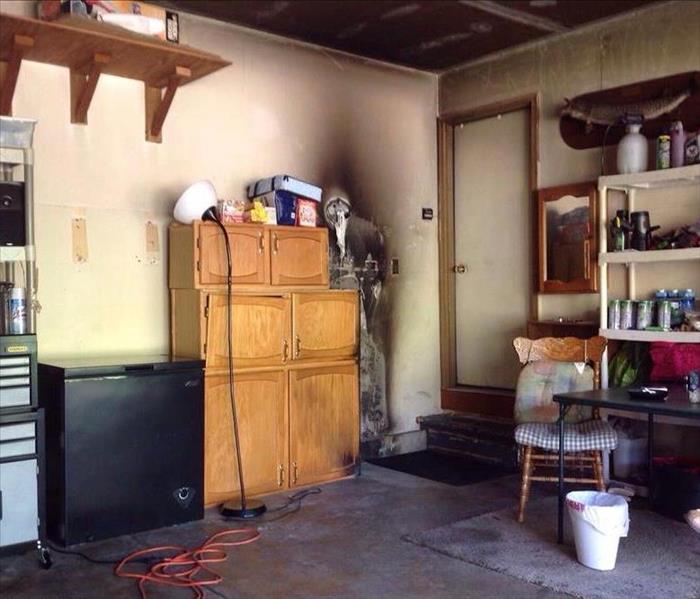 Here is where the fire started and there was smoke damage throughout the house.
Here is where the fire started and there was smoke damage throughout the house.
Any fire loss is a traumatic event for home or business owners, leaving you highly stressed and unsure of the process of getting life back to normal. SERVPRO of Southern McHenry County delivers compassionate and caring restoration services and guides you through the restoration process so you can recover as quickly and efficiently as possible.
Fire losses are often also water losses and represent a wide variety of technical challenges and SERVPRO of Southern McHenry County has the skills, specialized equipment and systems necessary to return structures back to their normal functioning condition. We thoroughly assess the damage caused by fire, smoke residue and water and start the restoration process immediately because fast action helps to minimize further and extensive fire and smoke damage.
Because SERVPRO of Southern McHenry County specializes in mitigation rather than reconstruction, we do everything possible to restore, rather than replace, damaged structure and even its contents in order to get the job done faster. We are the professionals at removing even the most difficult and persistent smoke odors in the Southern McHenry County area, as well as providing the kind of restorative cleaning required to return property and its' contents to preloss condition.
If you have any questions or you need emergency services call us at 847-516-1600.
Southern McHenry County Smoke and Soot Cleanup
7/21/2016 (Permalink)
Smoke and soot is very invasive and can penetrate various cavities within your home, causing hidden damage and odor. Our smoke damage expertise and experience allows us to inspect and accurately assess the extent of the damage to develop a comprehensive plan of action.
Smoke and soot facts:
Hot smoke migrates to cooler areas and upper levels of a structure.Smoke flows around plumbing systems, seeping through the holes used by pipes to go from floor to floor.The type of smoke may greatly affect the restoration process.Different Types of Smoke
There are two different types of smoke–wet and dry. As a result, there are different types of soot residue after a fire. Before restoration begins, SERVPRO of Southern McHenry County will test the soot to determine which type of smoke damage occurred. The cleaning procedures will then be based on the information identified during pretesting. Here is some additional information:
Wet Smoke – Plastic and Rubber
Low heat, smoldering, pungent odor, sticky, smeary. Smoke webs are more difficult to clean.Dry Smoke – Paper and Wood
Fast burning, high temperatures, heat rises therefore smoke rises.Protein Fire Residue – Produced by evaporation of material rather than from a fire
Virtually invisible, discolors paints and varnishes, extreme pungent odor. Our Fire Damage Restoration Services
Since each smoke and fire damage situation is a little different, each one requires a unique solution tailored for the specific conditions. We have the equipment, expertise, and experience to restore your fire and smoke damage. We will also treat your family with empathy and respect and your property with care.
Have Questions about Fire, Smoke, or Soot Damage?
Call Us Today – (847) 516-1600






 24/7 Emergency Service
24/7 Emergency Service


































